2024-2025 Public Opinion Research on Privacy Issues
Final Report
Prepared for the Office of the Privacy Commissioner of Canada
Supplier Name: Phoenix SPI
Contract Number: CW2385984
Award Date: 2024-12-19
Contract Value: $99.934.94 (including applicable taxes)
Delivery Date: 2025-03-31
Registration Number: POR No. 093-24
For more information, please contact: publications@priv.gc.ca
2024-2025 Public Opinion Research on Privacy Issues
Final Report
Prepared for the Office of the Privacy Commissioner of Canada
Supplier name: Phoenix Strategic Perspectives Inc.
March 2025
This public opinion research report presents the results of a telephone and online survey conducted by Phoenix SPI on behalf of the Office of the Privacy Commissioner of Canada. The telephone survey was conducted with 1,500 Canadians, aged 16 and older, between February 10 to March 3, 2025, and the online survey was conducted with 302 parents and 109 primary and secondary school teachers between February 25 and 28, 2025.
This publication may be reproduced for non-commercial purposes only. Prior written permission must be obtained from the Office of the Privacy Commissioner of Canada. For more information on this report, please contact the Office of the Privacy Commissioner of Canada at: publications@priv.gc.ca or at:
Office of the Privacy Commissioner of Canada
30, Victoria Street
Gatineau, Quebec
K1A 1H3
Catalogue Number: IP54-118/2025E-PDF
International Standard Book Number (ISBN): 978-0-660-77185-4
Related publications (POR registration number: 093-24):
Catalogue number (Final report, French): IP54-118/2025F-PDF
ISBN: 978-0-660-77186-1
Aussi offert en français sous le titre : Recherche sur l’opinion publique concernant les enjeux liés à la protection de la vie privée de 2024-2025
List of Figures
Figure 1: Concern about protection of personal privacy
Figure 2: General knowledge of privacy rights
Figure 3: Knowledge of how to protect privacy
Figure 4: Knowledge of existing privacy laws in Canada
Figure 5: Knowledge of how new technologies affect privacy
Figure 6: Knowledge of what to do if affected by a privacy breach
Figure 7: Views on whether businesses respect privacy rights
Figure 8: Views on whether the Government of Canada respects privacy rights
Figure 9: Trust in different organizations to protect personal information
Figure 10: Trust in different organizations to protect personal information over time
Figure 11: Level of concern about different activities
Figure 12: Concern about personal information being used to create marketing profiles
Figure 13: Concern about how personal information will be used to make decision about themselves
Figure 14: Concern about identity theft
Figure 15: Concern about personal information being sold or shared
Figure 16: Concern about personal information being used to train AI systems
Figure 17: Percentage impacted by a privacy breach
Figure 18: Actions taken to protect privacy
Figure 19: Ease of understanding privacy policies
Figure 20: Ease of changing privacy settings
Figure 21: Willingness to share personal information with organizations compared to 5 years ago
Figure 22: Attitudes towards sharing personal information
Figure 23: Awareness of federal institutions that deal with privacy
Figure 24: Awareness of the Privacy Commissioner of Canada
Figure 25: Use of OPC resources
Figure 26: Percentage that have made a privacy complaint
Figure 28: Privacy topics Canadians would like more information on
Figure 29: Ways of getting privacy information
Figure 30: Concerns about online activities and privacy implications
Figure 31: Perceptions of child’s/teen’s awareness of the risks of sharing personal information
Figure 32: Ranking of actors re: responsibility for protecting privacy of children and teens
Figure 33: Perceived responsibility for guiding child/teen in making safe online decisions
Figure 34: Views on parental involvement in their child/teen’s online activities
Figure 35: Percentage that discussed the protection of personal information with their child/teen
Figure 37: Frequency of discussing the protection of personal information with their child/teen
Figure 38: Topics discussed with their child/teen
Figure 39: Trust in companies to protect the personal information of young people
Figure 40: Frequency of considering the privacy practices of services used by their child/teen
Figure 41: Use of parental controls
Figure 42: Reasons for not applying parental controls
Figure 43: Awareness of programs or resources for children about privacy and safe online practices
Figure 45: Use of OPC resources
Figure 46: Resource topics parents would find helpful
Figure 47: Information sources on parenting topics
Figure 49: Areas of concern about students and privacy
Figure 51: Perceptions of students' ability to protect their online privacy
Figure 56: Topics addressed in classroom
Figure 57: Awareness of teaching programs or resources about privacy and safe online practices
Figure 58: Percentage that review privacy practices before using educational tools in the classroom
Figure 59: Reasons for not reviewing privacy practices of education tools
Figure 60: Awareness of federal privacy institutions
Figure 61: Use of OPC resources
Figure 62: Resources that would be helpful to educators
Executive Summary
The Office of the Privacy Commissioner of Canada (OPC) commissioned Phoenix Strategic Perspectives Inc. (Phoenix SPI) to conduct a telephone survey of Canadians and an online survey of parents and teachers on privacy-related issues.
1. Research Purpose and Objectives
The Privacy Commissioner of Canada is an Agent of Parliament whose mission is to protect and promote the privacy rights of Canadians. To fulfill this mandate, the OPC must understand Canadians’ knowledge of their privacy rights and the key challenges that they face in protecting their personal information. This research had two main objectives: to assess Canadians’ awareness and understanding of their privacy rights and related issues, and to explore the concerns of parents and teachers about the privacy of children and teens.
The OPC will use the survey findings to better understand Canadians’ concerns and attitudes towards privacy, their awareness of privacy institutions, and their views on managing their personal information. This insight will inform and guide outreach efforts. Additionally, the OPC uses the data for accountability purposes, such as Departmental Results Reports, and to track progress on key priorities, including children’s privacy and artificial intelligence.
2. Methodology
A 19-minute random digit dialling (RDD) telephone survey was administered to 1,500 Canadian residents, 16 years of age or older between February 10 and March 3, 2025. Data were weighted to reflect the population in terms of age, gender, and region. The results can be considered representative of the population of Canadians aged 16 and older. Based on a sample of this size, the overall results can be considered accurate within ±2.5%, 19 times out of 20.
In addition, an eight-minute non-probability online survey was conducted with 302 parents of children between the ages of six and 17 years and 109 primary and secondary school teachers. The fieldwork took place February 25 to 28, 2025. The parent data have been weighted by region and age to match the population. The teacher data have not been weighted. Because the samples are based on those who initially self-selected for participation in the panel, no estimates of sampling error can be calculated.
3. Key Findings
The vast majority of Canadians expressed some level of concern about protecting their privacy. Fewer are knowledgeable about existing privacy laws, their privacy rights, and how to protect their privacy.
Nine in 10 Canadians (89%) are at least somewhat concerned about the protection of their privacy, including 36% who are extremely concerned. Despite widespread concern about privacy protection, just a minority of Canadians rated their knowledge of existing privacy laws as good (27%) or very good (6%). Close to half rated their knowledge of their privacy rights as good (34%) or very good (13%) and over half said that they have good (45%) or very good (14%) knowledge of how to protect their privacy. Fifty-five percent are confident that they have enough information to understand how new technologies impact their privacy.
Six in 10 Canadians surveyed are confident that government respects their privacy rights; fewer feel this way about businesses. Law enforcement and banks/financial institutions rate the highest among Canadians when it comes to trust.
Six in 10 Canadians (62%; up from 58% in 2022) believe that the Government of Canada respects their privacy rights and four in 10 (40%) believe that businesses do. When the focus is on trust, eight in 10 Canadians (80%) trust law enforcement and roughly three-quarters (77%) trust banks and financial institutions to protect the personal information that they share with them. Fewer than half (42%) trust telecommunications companies and internet service providers, while smaller proportions reported having trust in retailers (37%) and “Big Tech” (28%). Canadians expressed the lowest level of trust in social media companies, with just 12% saying that they trust them to protect their personal information.
Canadians are concerned about their privacy across various digital activities and about how their personal information may be used.
While concern levels vary, most Canadians are at least somewhat concerned about their privacy when using social media (87%), smartphones (86%), AI tools (83%), and other internet-connected devices (84%), as well as when providing personal information or biometrics (85%) and engaging in online activities (87%). Concern is particularly high for AI tools and social media, with approximately one-third of Canadians (34% and 32%, respectively) saying that they are extremely concerned.
Canadians are also concerned about how their personal information is used. Nine in ten (91%) expressed at least some concern about their data being used to create marketing profiles or to commit identity theft. Similarly, 87% are concerned about their information being used for decisions that impact their lives, such as employment, insurance claims, loans, or health coverage. Reflecting this broader unease, a vast majority are concerned specifically about their personal data being sold or shared with third parties (92%) or used to train AI systems (88%).
Highlighting their concerns about privacy protection, many Canadians have taken actions to protect themselves and most are less willing to share their personal information with organizations compared to five years ago. Still, there is room for improvement, especially in relation to privacy policies.
Compared to five years ago, three-quarters of Canadians are somewhat less (28%) or much less (47%) willing to share their personal information with organizations. In terms of actions taken to protect their privacy, more than three-quarters (78%) have refused to provide an organization or business their personal information due to privacy concerns. Three-quarters (75%) have adjusted privacy settings on a social media account, while two-thirds (67%) have adjusted these settings for other online or mobile app accounts. Additionally, just over half (52%) have deleted or stopped using an account because of privacy concerns, and 41% have stopped doing business with a company that experienced a privacy breach.
While it is encouraging that many Canadians are taking actions to protect their privacy, a majority find it difficult to understand privacy policies (71%) and adjust the privacy settings of their online accounts (53%). Additionally, two-thirds (67%) do not know where the personal information they share online goes, or how it is used, 50% often feel tricked or pressured into giving more personal information than they think is needed to set up an online account, and 43% do not find it easy to delete an online account.
Half of Canadians are aware of the Privacy Commissioner of Canada though few have used privacy resources, guidance or other information from the OPC.
Twenty-six percent of Canadians said that they are aware of federal institutions that help Canadians deal with privacy and the protection of personal information. When asked if they have heard of the Privacy Commissioner of Canada, 50% of them responded in the affirmative. The findings point to a gap in public awareness and engagement, as only 8% of Canadians have accessed resources, guidance, or other privacy-related information from the OPC. Despite widespread privacy concerns, most Canadians are not using the support and information made available to them by the OPC.
Parents and teachers are concerned about privacy protection and young people, and many are not aware of resources that could help them discuss privacy and related issues with children and teens.
Parents and teachers are at least moderately concerned about the amount of personal information companies collect about young people (69% of parents, 78% of teachers), the amount of personal information young people share online (65%, 78%, respectively), young people using websites and apps designed for adults (69%, 80%), and the risks to young people from the use or misuse of their personal information (73%, 75%). Despite strong concerns about privacy and young people, many teachers and parents lack awareness of available tools and materials: 31% of teachers and even fewer parents (18%) are aware of programs or resources that teach children or teens about privacy and safe online practices.
Statement of Political Neutrality
I hereby certify as a Senior Officer of Phoenix Strategic Perspectives that the deliverables fully comply with the Government of Canada political neutrality requirements outlined in the Communications Policy of the Government of Canada and Procedures for Planning and Contracting Public Opinion Research. Specifically, the deliverables do not contain any reference to electoral voting intentions, political party preferences, standings with the electorate, or ratings of the performance of a political party or its leader.
(Original signed by)
Alethea Woods
President
Phoenix Strategic Perspectives Inc.
The contract value was $99.934.94 (HST included).
Introduction
Phoenix Strategic Perspectives Inc. (Phoenix SPI) was commissioned by the Office of the Privacy Commissioner of Canada (OPC) to conduct a telephone survey of Canadians and an online survey of parents and teachers on privacy-related issues.
1. Background and Objectives
The Privacy Commissioner of Canada is an Agent of Parliament whose mission is to protect and promote the fundamental privacy rights of Canadians. The Office of the Privacy Commissioner of Canada oversees compliance with the Privacy Act, which covers the personal information-handling practices of federal government departments and agencies, and the Personal Information Protection and Electronic Documents Act (PIPEDA), Canada’s federal private-sector privacy law.
The OPC carries out its mission to protect and promote the privacy rights of individuals in a variety of ways. For example:
- Investigating complaints, conducting audits and pursuing court action under Canada’s two federal privacy laws;
- Publicly reporting on the personal information handling practices of public and private sector organizations;
- Supporting, undertaking and publishing research into privacy issues; and
- Promoting public awareness and understanding of privacy issues.
To fulfill this mandate, the OPC must understand Canadians’ knowledge of their privacy rights and the key challenges that they face in protecting their personal information. For this reason, the OPC conducts surveys with Canadians every two years. The last wave was conducted in 2022-23. The purpose of this public opinion research (POR) is to assess Canadians’ awareness, understanding, and perceptions of privacy-related issues, as well as to measure awareness of the OPC’s resources, programs, and services.
This year, in addition to the telephone survey of Canadians, a supplementary online survey of parents and teachers was conducted as part of this POR study. The purpose of the online survey was to gauge parents’ and teachers’ concerns about the protection of children’s and teens’ privacy.
The OPC will use the findings of both surveys to better understand Canadians’ concerns and attitudes towards privacy, their awareness of privacy institutions, and their views on managing their personal information. This insight will inform and guide outreach efforts. Additionally, the OPC uses the data for accountability purposes, such as Departmental Results Reports, and to track progress on key priorities, including children’s privacy and artificial intelligence. It is also used to improve service delivery and to develop resources for Canadians.
2. Methodology
To meet the objectives of this study, two surveys were conducted as follows:
- A 19-minute random digit dialling (RDD) telephone survey was administered to 1,500 Canadian residents, 16 years of age or older between February 10 and March 3, 2025. An overlapping dual-frame (landline and cell phone) sample was used to minimize coverage error. Data were weighted to reflect the population in terms of age, gender, and region. The results can be considered representative of the population of Canadians aged 16 and older. Based on a sample of this size, the overall results can be considered accurate within ±2.5%, 19 times out of 20. The margin of error is greater for results pertaining to subgroups of the total sample.
- An eight-minute non-probability online survey was conducted with 302 parents of children between the ages of 6 and 17 years and 109 primary and secondary school teachers. The fieldwork took place February 25 to 28, 2025. The parent data have been weighted by region and age to match the population. The teacher data have not been weighted. Because the samples are based on those who initially self-selected for participation in the panel, no estimates of sampling error can be calculated.
For a more complete description of the methodology, refer to the Appendix: 1. Technical Specifications.
3. Notes to Reader
- The report is divided into two chapters. The first presents the results of the telephone survey and the second, the results of the online survey.
- The question wording, the number of respondents, and the target population is shown under each figure in the report.
- All results in the report are expressed as a percentage, unless otherwise noted. Throughout the report, percentages may not always add to 100 due to rounding and/or multiple responses being offered by respondents.
- Telephone survey:
- The total number of survey respondents is 1,500. At times, the number of respondents changes in the report because questions were asked of sub-samples of the survey population. Accordingly, readers should exercise caution when interpreting results based on smaller numbers of respondents.
- This report highlights differences in survey responses among selected subgroups of the sample. Only statistically significant differences at the 95% confidence level are included, as well as those that involve a subgroup of at least 30 respondents. If no subgroup differences are mentioned for certain questions, it can be assumed that none were significant.
- Reference is made to findings from similar surveys conducted in previous years. Changes over time are highlighted only if they exceed the margin of error for the overall sample.
- Online survey:
- The total number of survey respondents is 302 parents and 109 teachers. The results are presented first for parents and then for teachers. Readers should exercise caution when interpreting results based on smaller numbers of respondents.
- Because this is a non-probability survey, a margin of sampling error cannot be provided for the results.
- Two sets of tabulated data are available under separate cover.
- The survey questionnaires can be found in the Appendix along with more information about the technical specifications of the research.
Detailed Findings
1. Telephone Survey
This section of the report presents the findings of the biennial RDD telephone survey of 1,500 Canadians.
1.1 General Concern and Privacy Knowledge
The vast majority of Canadians expressed some level of concern about protecting their privacy
Nine in 10 Canadians (89%) are at least somewhat concerned about the protection of their privacy, including 36% who are extremely concerned. Very few Canadians (10%) are not concerned about protecting their privacy. Over time, concern about personal privacy has been very consistent, with extreme concern ranging from a low of 32% in 2020 to a high of 38% in 2022. Comparing 2022 to 2024, the level of concern among Canadians has not changed in any significant way.
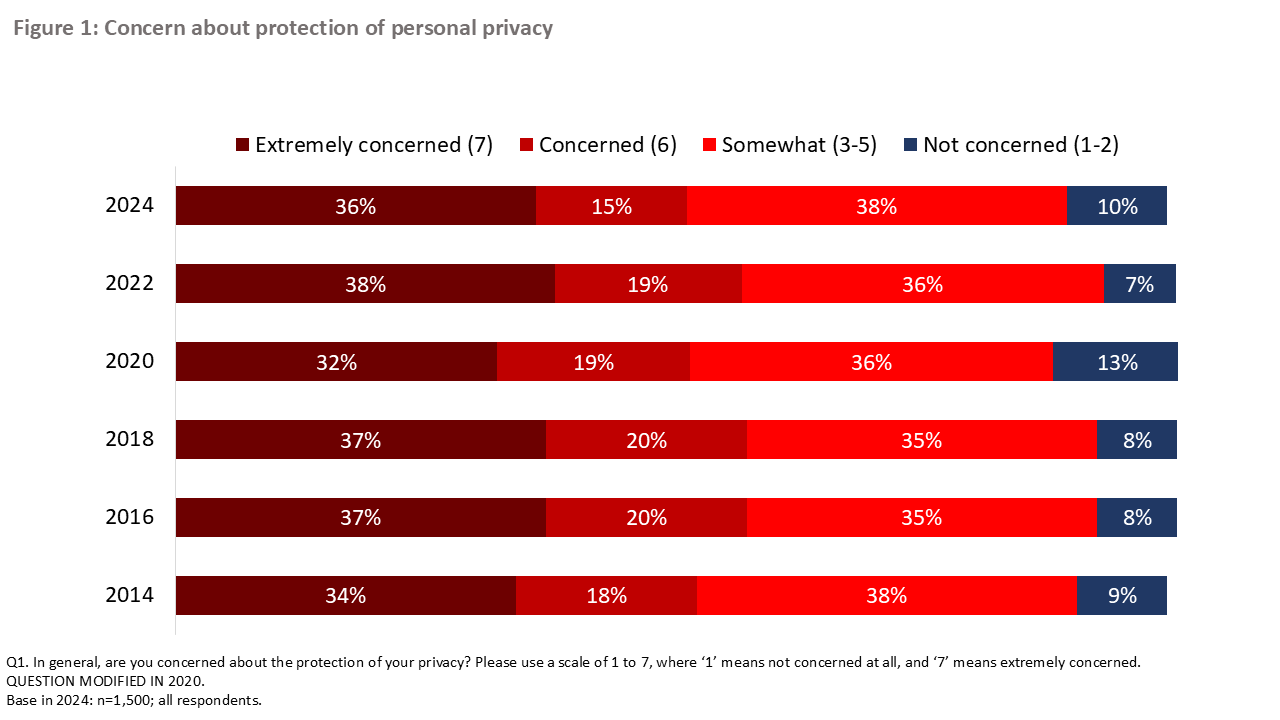
Text version of Figure 1
Figure 1: Concern about protection of personal privacy
Q1. In general, are you concerned about the protection of your privacy? Please use a scale of 1 to 7, where ‘1’ means not concerned at all, and ‘7’ means extremely concerned?
Question modified in 2020.
| Year | Not concerned (1-2) | Somewhat (3-5) | Concerned (6) | Extremely concerned (7) |
|---|---|---|---|---|
| 2024 | 10% | 38% | 15% | 36% |
| 2022 | 7% | 36% | 19% | 38% |
| 2020 | 13% | 36% | 19% | 32% |
| 2018 | 8% | 35% | 20% | 37% |
| 2016 | 8% | 35% | 20% | 37% |
| 2014 | 9% | 38% | 18% | 34% |
| Base in 2024: n=1,500; all respondents. | ||||
As was the case in 2022 and 2020, concern about privacy remained higher in Quebec and among those aged 35 and older. In Quebec, 61% of respondents reported being very or extremely concerned about privacy protection, compared to 51% in Atlantic Canada, 52% in Ontario, 47% in the Prairies, and 43% in British Columbia. Concern also increased with age: 29% of 16- to 24-year-olds and 41% of 25- to 34-year-olds reported high levels of concern, compared to 57% of 35- to 54-year-olds, 62% of 55- to 64-year-olds, and 56% of those 65 and older. Additionally, those who consider themselves very knowledgeable about how to protect their privacy rights were more likely to express strong concern (60%) than those who are somewhat knowledgeable (49%) or not knowledgeable (42%).
Nearly half of Canadians claim to be knowledgeable about their privacy rights
Close to half of the Canadians surveyed rated their knowledge of their privacy rights as good (34%) or very good (13%). Conversely, just under one-third assessed their knowledge as poor (24%) or very poor (7%). While Canadians’ reported knowledge of their privacy rights was very consistent from 2016 to 2020, 2022 marked a significant change when self-assessed knowledge declined 13 percentage points between 2020 and 2022. The trend continued this year, although the decline over time was much smaller (from 51% in 2022 to 47% in 2024). Overall, Canadians’ self-assessed knowledge of their privacy rights has been declining since 2020.
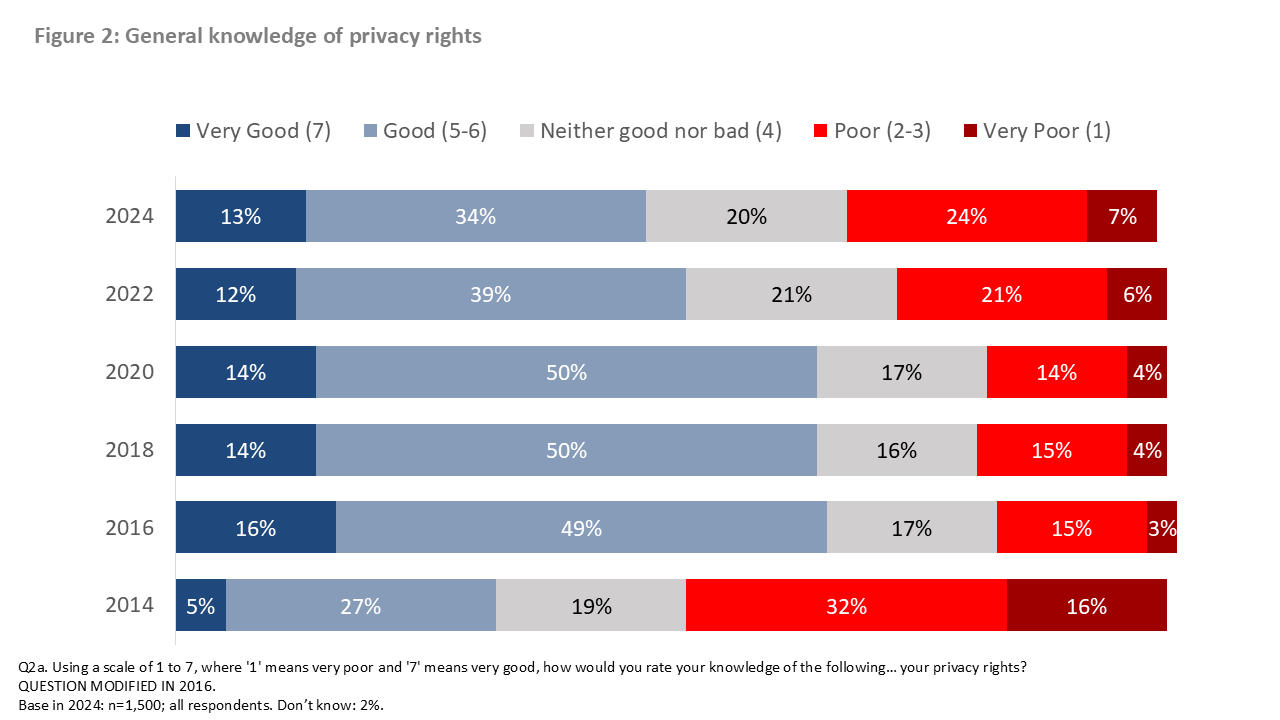
Text version of Figure 2
Figure 2: General knowledge of privacy rights
Q2a. Using a scale of 1 to 7, where ‘1’ means very poor and ‘7’ means very good, how would you rate your knowledge of the following… your privacy rights?
Question modified in 2016.
| Year | Very Good (7) | Good (5-6) | Neither good nor bad (4) | Poor (2-3) | Very Poor (1) |
|---|---|---|---|---|---|
| 2024 | 13% | 34% | 20% | 24% | 7% |
| 2022 | 12% | 39% | 21% | 21% | 6% |
| 2020 | 14% | 50% | 17% | 14% | 4% |
| 2018 | 14% | 50% | 16% | 15% | 4% |
| 2016 | 16% | 49% | 17% | 15% | 3% |
| 2014 | 5% | 27% | 19% | 32% | 16% |
| Base in 2024: n=1,500; all respondents. Don’t know: 2%. | |||||
Self-assessed knowledge was significantly higher in Quebec (62%) and Atlantic Canada (54%) than in Ontario (42%), the Prairies (42%), and British Columbia (41%). It was also higher among Canadians aged 55+ (55%) compared to 16- to 24-year-olds (31%). Additionally, it was higher among Canadians who are very concerned about the protection of their privacy (56%) and those who consider themselves very knowledgeable about how to protect their privacy (77%).
Many Canadians believe that they know how to protect their privacy
Six in 10 Canadians (59%) rated their knowledge of how to protect their privacy as good (45%) or very good (14%). In contrast, two in 10 said they have poor (17%) or very poor (4%) knowledge of how to protect their privacy.Footnote 1

Text version of Figure 3
Figure 3: Knowledge of how to protect privacy
Q2b. Using a scale of 1 to 7, where ‘1’ means very poor and ‘7’ means very good, how would you rate your knowledge of the following… how to protect your privacy?
Question modified in 2024.
| Year | Very Good (7) | Good (5-6) | Neither (4) | Poor (2-3) | Very Poor (1) |
|---|---|---|---|---|---|
| 2024 | 14% | 45% | 19% | 17% | 4% |
| 2022 | 13% | 38% | 19% | 23% | 7% |
| 2020 | 12% | 46% | 19% | 19% | 4% |
| 2018 | 11% | 46% | 19% | 19% | 4% |
| Base in 2024: n=1,500; all respondents. Don’t know: 1%. | |||||
Knowledge of how to protect one’s privacy was higher in Quebec: 66% said they have good or very good knowledge in this area compared to residents of Ontario (55%), the Prairies (57%), and British Columbia (56%).
Canadians rate their knowledge of existing privacy laws lower than their understanding of privacy rights and how to protect their privacy
One-third (33%) of Canadians surveyed rated their knowledge of existing privacy laws as good (27%) or very good (6%). Conversely, 43 percent reported that they had poor (30%) or very poor (13%) knowledge of existing privacy laws.

Text version of Figure 4
Figure 4: Knowledge of existing privacy laws in Canada
Q2c. Using a scale of 1 to 7, where ‘1’ means very poor and ‘7’ means very good, how would you rate your knowledge of the following… existing privacy laws?
| Level of knowledge | % of respondents |
|---|---|
| Very Good (7) | 6% |
| Good (5-6) | 27% |
| Neither (4) | 22% |
| Poor (2-3) | 30% |
| Very Poor (1) | 13% |
| Base: n=1,500; all respondents. Don’t know: 2%. | |
The following groups of Canadians were more likely to say that they have good or very good knowledge of existing privacy laws:
- residents of Atlantic Canada (41%) and Quebec (40%) compared to the Prairies (28%);
- Canadians aged 25+ (30% of 25- to 34-year-olds, 39% of 35- to 54-year-olds, and 38% of 55+ versus 12% of 16- to 24-year-olds);
- University graduates (37% compared to 28% of those with high school or less); and
- Canadians who said that they were very concerned about the protection of their personal privacy (41% versus 25% of those somewhat concerned) and who rated themselves as very knowledgeable about how to protect their privacy (62% versus 23% of those somewhat knowledgeable).
The majority of Canadians feel confident about their knowledge of the privacy implications of new technologies
More than half of those surveyed (55%) are confident that they know how new technologies might impact their privacy. In contrast, 45% do not feel confident, including 32% who disagreed with the statement I feel confident that I know how new technologies might affect my personal privacy. Confidence has increased since 2022 and is now at its highest level in a decade.Footnote 2

Text version of Figure 5
Figure 5: Knowledge of how new technologies affect privacy
“I feel confident that I know how new technologies might affect my personal privacy.”
Q3c. Please tell me how much you agree or disagree with the following statements. To do so, use another 7-point scale, this time where ‘1’ means you strongly disagree and ‘7’ means you strongly agree.
QUESTION MODIFIED IN 2024
| Year | Agree (5-7) | Neutral (4) | Disagree (1-3) |
|---|---|---|---|
| 2024 | 55% | 13% | 32% |
| 2022 | 48% | 17% | 34% |
| 2020 | 52% | 17% | 30% |
| 2018 | 48% | 18% | 34% |
| 2016 | 52% | 15% | 32% |
| 2014 | 43% | 15% | 41% |
| Base in 2024: n=1,500; all respondents. | |||
The following groups of Canadians were less likely to feel confident that they know how new technologies might affect their personal privacy: Canadians aged 55+ (49% compared to 66% of 25- to 34-year-olds and 57% of 35- to 54-year-olds); women (51%); and those who said that they were not knowledgeable about how to protect their privacy (43% compared to 75% of those who said that they are very knowledgeable).
Almost half do not know what to do about a privacy breach.
Forty-seven percent of Canadians agreed with the statement: I don’t know what to do if I think that my personal information is part of a privacy breach. In contrast, slightly more than one-third (37%) feel that they do know what to do if they think their personal information has been part of a privacy breach.

Text version of Figure 6
Figure 6: Knowledge of what to do if affected by a privacy breach
“I don’t know what to do if I think that my personal information is part of a privacy breach.”
Q3d. Please tell me how much you agree or disagree with the following statements. To do so, use another 7-point scale, this time where ‘1’ means you strongly disagree and ‘7’ means you strongly agree.
| Level of agreement | % of respondents |
|---|---|
| Agree (5-7) | 47% |
| Neither (4) | 14% |
| Disagree (1-3) | 37% |
| Base: n=1,500; all respondents. Don’t know: 1%. | |
Canadians aged 55+ (49% versus 43% of those aged 35 to 54) and those with household incomes under $40,000 (53% versus 40% of those with incomes of $80,000 to just under $150,000 and 43% of those earning $150,000 and above) were more likely to agree that they don’t know what to do if they think that their personal information is part of a privacy breach.
1.2 Confidence and Trust in Organizations to Protect Privacy
Four in 10 Canadians are confident that businesses respect their privacy rights
Four in 10 Canadians (40%) believe that businesses respect their privacy rights, while a similar proportion (42%) disagree. Trust in businesses increased from 38% in 2018 to 45% in 2020 but has remained steady since 2022. This year’s results align with the 2018 baseline.

Text version of Figure 7
Figure 7: Views on whether businesses respect privacy rights
“I feel that businesses in general respect my privacy rights.”
Q3a. Please tell me how much you agree or disagree with the following statements. To do so, use another 7-point scale, this time, where ‘1’ means you strongly disagree and ‘7’ means you strongly agree. [SPLIT SAMPLE: 50% Q3a / 50%: Q3b]
| Year | Agree (5-7) | Neutral (4) | Disagree (1-3) |
|---|---|---|---|
| 2024 | 40% | 17% | 42% |
| 2022 | 39% | 15% | 45% |
| 2020 | 45% | 18% | 36% |
| 2018 | 38% | 17% | 45% |
| Base in 2024: n=750; half of respondents. Don’t know: 1%. | |||
Quebec residents (49%) were more likely to agree that businesses respect peoples’ privacy rights than those in British Columbia (35%). Agreement was also higher among those with a household income under $40,000 (53%) compared to those earning $80,000 to $149,999 (34%) or $150,000 and above (36%). Similarly, those who consider themselves very knowledgeable about how to protect their privacy (54%) were more likely to agree than those who are somewhat knowledgeable (36%) or not knowledgeable (23%).
Six in 10 Canadians are confident that the federal government respects their privacy rights
Six in 10 Canadians (62%) believe that the Government of Canada respects their privacy rights. This represents a four-percentage point increase from 2022, when 58% of respondents agreed that the federal government in general respects their privacy rights. One-quarter (24%) disagreed, indicating that they do not feel that their privacy rights are respected by the Government of Canada.
Agreement that the Government of Canada respects the privacy rights of individuals was highest among those in Quebec (80%).
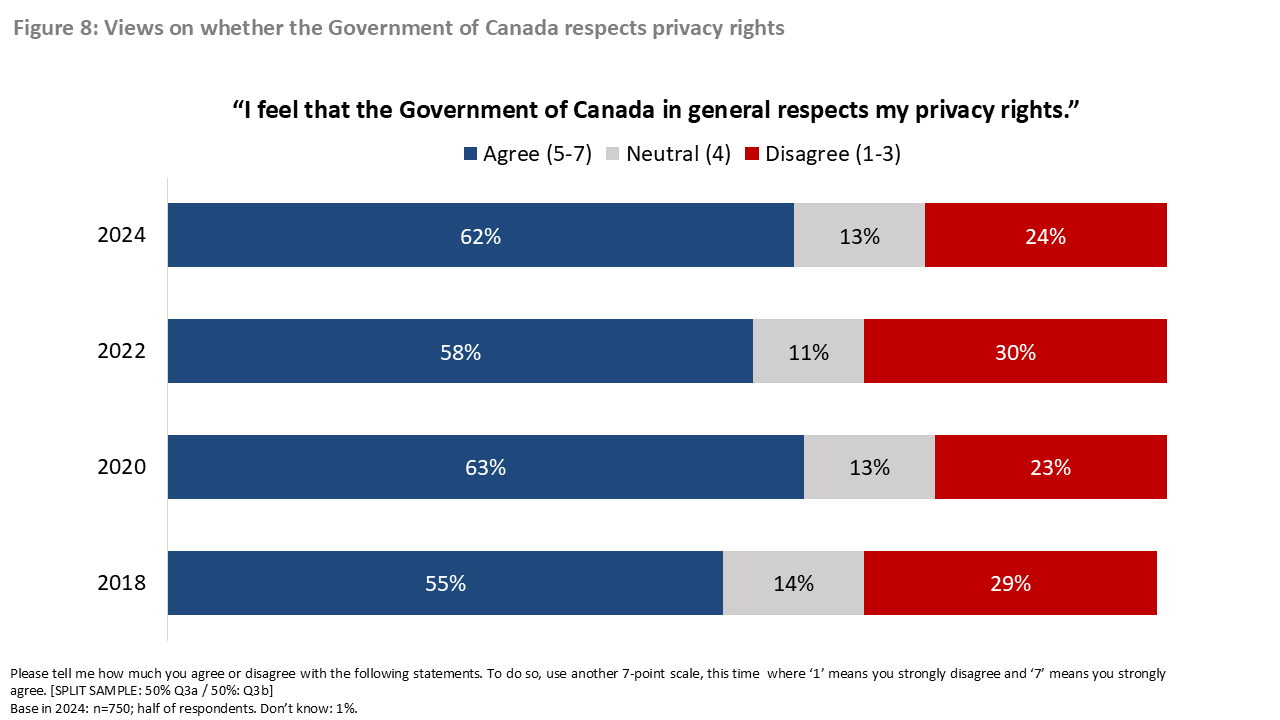
Text version of Figure 8
Figure 8: Views on whether the Government of Canada respects privacy rights
“I feel that the Government of Canada in general respects my privacy rights.”
Q3b. Please tell me how much you agree or disagree with the following statements. To do so, use another 7-point scale, this time where ‘1’ means you strongly disagree and ‘7’ means you strongly agree. [SPLIT SAMPLE: 50% Q3a / 50%: Q3b]
| Year | Agree (5-7) | Neutral (4) | Disagree (1-3) |
|---|---|---|---|
| 2024 | 62% | 13% | 24% |
| 2022 | 58% | 11% | 30% |
| 2020 | 63% | 13% | 23% |
| 2018 | 55% | 14% | 29% |
| Base in 2024: n=750; half of respondents. Don’t know: 1%. | |||
Majority trust law enforcement and banks to protect their personal information; limited trust in other organizations
When asked to rate their level of trust in various organizations, eight in 10 Canadians (80%) said that they have at least a fair amount of trust in law enforcement agencies like police and border officers to protect the personal information they share with them. A similar proportion (77%) said that they have at least a fair amount of trust in banks and financial institutions.

Text version of Figure 9
Figure 9: Trust in different organizations to protect personal information
Q4. How much trust do you have in the following organizations to protect the personal information you share with them?
| Organizations | Great deal of trust | Fair amount of trust | Not much trust | No trust at all |
|---|---|---|---|---|
| Law enforcement | 32% | 48% | 12% | 7% |
| Banks and financial institutions | 25% | 52% | 16% | 6% |
| Telcos and ISPs | 5% | 37% | 37% | 19% |
| Retailers | 3% | 34% | 40% | 21% |
| “Big Tech” | 5% | 23% | 37% | 34% |
| Social media companies | 1% | 11% | 37% | 49% |
| Base: n=1,500; all respondents. Don’t know ranged from <0.5% to 2%. | ||||
Fewer than half (42%) indicated that they have a fair amount or a great deal of trust in telecommunications companies and internet service providers, while smaller proportions reported some level of trust in retailers (37%) and “Big Tech” (28%). Canadians expressed the lowest level of trust in the ability of social media companies to protect their personal information – 12% have a fair amount or a great deal of trust and 86% have not much or no trust at all.
Trust in law enforcement (87%) and telecom/internet providers (50%) was higher in Quebec than in other regions. Canadians aged 65+ were more likely to trust retailers (45%), while Canadians under 35 were more likely to trust “Big Tech” (43% of 16–24-year-olds and 34% of 25–34-year-olds). Trust in “Big Tech” (38%) and social media companies (20%) was higher among members of racialized populations. Those who feel knowledgeable about protecting their privacy were more likely to trust law enforcement (84%), telecom/internet providers (48%), “Big Tech” (35%), and social media (18%).
Since 2022, trust in law enforcement has increased slightly (from 75% to 80% in 2024), while trust in “Big Tech” continues to decline (from 39% in 2020 to 34% in 2022 and 28% this year). Canadians’ perceptions in other areas have remained stable.

Text version of Figure 10
Figure 10: Trust in different organizations to protect personal information over time
| Organizations | 2024 | 2022 | 2020 |
|---|---|---|---|
| Law enforcement | 80% | 75% | |
| Banks and financial institutions* | 77% | 75% | 81% |
| Telcos and ISPs** | 42% | 42% | 47% |
| “Big Tech” | 28% | 34% | 39% |
| Retailers*** | 37% | 36% | 40% |
| Social media companies | 12% | 10% | 17% |
| *Was only ‘banks’ in 2020 and 2022. | |||
| **Was ‘internet companies’ in 2020. | |||
| ***Was ‘online’ retailers in 2020. | |||
1.3 Privacy Concerns
Strong majorities concerned about their privacy in certain situations
New this year, Canadians were asked whether they are concerned about their privacy in different situations or using specific technologies. While concern levels vary, most Canadians are at least somewhat concerned about their privacy. Approximately one-third are extremely concerned about privacy when using AI tools (34%) and social media (32%). About one-quarter feel the same about providing personal information or biometrics (28%) and using internet-connected devices related to things like smart homes or smart car technology (25%). Additionally, 23% are extremely concerned about their online activities, and 21% about their smartphone.

Text version of Figure 11
Figure 11: Level of concern about different activities
Q5. Are you concerned about your privacy with respect to the following… [READ ITEM]. Please use a scale from 1 to 7, where ‘1’ means not concerned at all, and ‘7’ means extremely concerned.
| Activities | Not concerned (1-2) | Somewhat (3-5) | Concerned (6) | Extremely concerned (7) |
|---|---|---|---|---|
| Using AI tools | 14% | 34% | 15% | 34% |
| Using social media | 12% | 39% | 16% | 32% |
| Providing personal information or biometrics | 13% | 41% | 16% | 28% |
| Using other internet-connected devices | 14% | 44% | 15% | 25% |
| Your online activities | 13% | 44% | 20% | 23% |
| Your smartphone | 14% | 46% | 19% | 21% |
| Base: those with access to the internet. Don’t know ranged from <0.5% to 3%. | ||||
Those who indicated that they were very concerned about the protection of their personal privacy were more likely to be very concerned about their privacy in each of these areas. The only other consistent pattern related to age. The youngest Canadians (16–24-year-olds) were less likely to be very concerned about using social media (28%) and AI tools (32%), biometrics (25%), and their smartphone (18%) and other connected devices (21%).
Widespread concern about personal information being used to create profiles
Nine in 10 Canadians (91%) are at least somewhat concerned about their personal information being used to create marketing profiles based on their interests and traits, including 43% who are extremely concerned. Concern over this issue has remained consistent over time.Footnote 3

Text version of Figure 12
Figure 12: Concern about personal information being used to create marketing profiles
“Your personal information being used to create profiles about you, your interests and personal traits for marketing purposes.”
Q6a. Thinking about the personal information available about you online, and in smart devices, please tell me whether you’re concerned about “Your personal information being used to create profiles about you, your interests and personal traits for marketing purposes.” To do so, I’d like you to use a 7-point scale, where ‘1’ means you’re not at all concerned and ‘7’ means you’re extremely concerned. [QUESTION MODIFIED IN 2024]
| Level of concern | 2024 | 2022 | 2020 |
|---|---|---|---|
| Extremely concerned (7) | 43% | 44% | 37% |
| Concerned (6) | 17% | 17% | 20% |
| Somewhat concerned (3-5) | 31% | 28% | 31% |
| Not concerned (1-2) | 8% | 11% | 10% |
| Base in 2024: n=1,467; those with access to the internet. | |||
Canadians aged 55+ were more likely than younger Canadians to express concern about their personal information being used to create a profile of their interests and personal traits for marketing purposes. The likelihood of expressing concern increased with age, from 47% of 16- to 24-year-olds, to 56% of 25- to 34-year-olds, to 59% of 35- to 54-year-olds, to 66% of those 55 and older. Additionally, concern was higher among those with a college (63%) or university (62%) education and those who are very concerned about the protection of their personal privacy (71%).
Majority are concerned about personal information being used to make decisions about them
Eighty-seven percent (87%) of Canadians are at least somewhat concerned about their personal information being used to make decisions about them, such as for a job, an insurance claim, a loan, or health coverage. Concern in this area has been stable since 2018, although there has been a small increase this year in the proportion of Canadians who are extremely concerned (32% in 2024 compared to 28% in 2022).Footnote 4
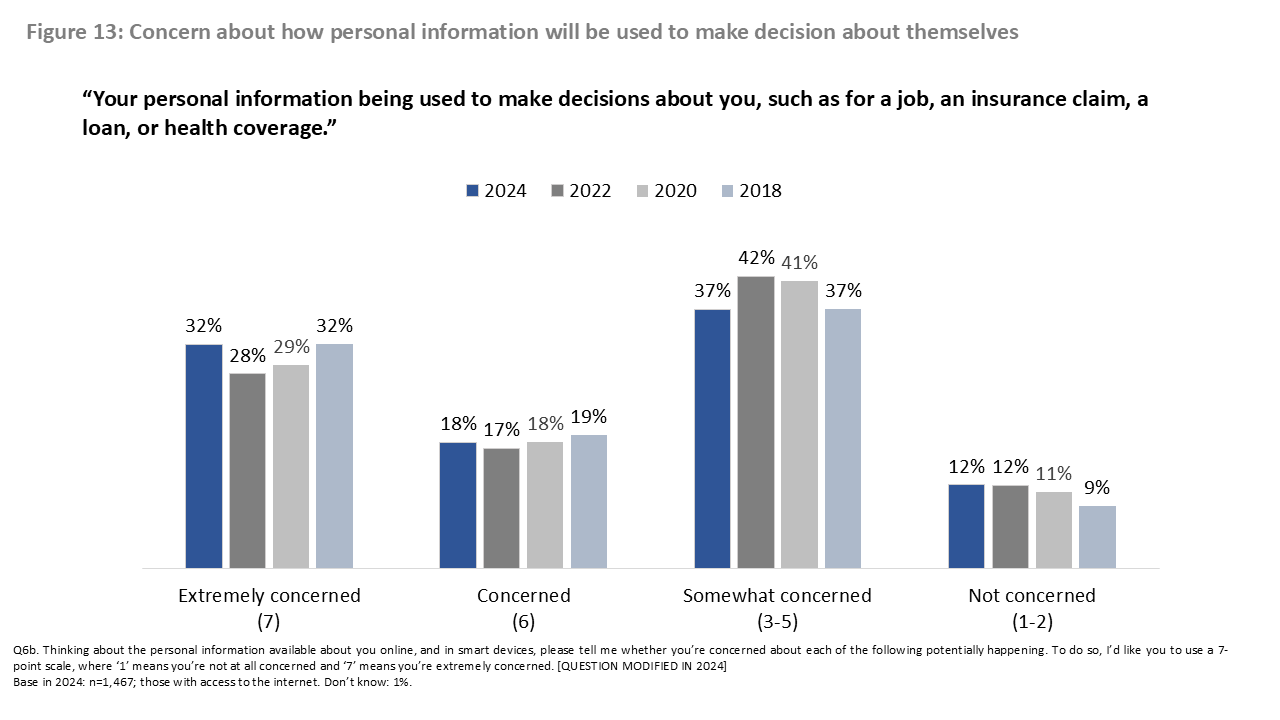
Text version of Figure 13
Figure 13: Concern about how personal information will be used to make decision about themselves
“Your personal information being used to make decisions about you, such as for a job, an insurance claim, a loan, or health coverage.”
Q6b. Thinking about the personal information available about you online, and in smart devices, please tell me whether you’re concerned about each of the following potentially happening. To do so, I’d like you to use a 7-point scale, where ‘1’ means you’re not at all concerned and ‘7’ means you’re extremely concerned. [QUESTION MODIFIED IN 2024]
| Level of concern | 2024 | 2022 | 2020 | 2018 |
|---|---|---|---|---|
| Extremely concerned (7) | 32% | 28% | 29% | 32% |
| Concerned (6) | 18% | 17% | 18% | 19% |
| Somewhat concerned (3-5) | 37% | 42% | 41% | 37% |
| Not concerned (1-2) | 12% | 12% | 11% | 9% |
| Base in 2024: n=1,467; those with access to the internet. Don’t know: 1%. | ||||
The likelihood of expressing concern (scores of six and seven on the seven-point scale) about their personal information being used for decision-making increased with age, from 37% of 16- to 24-year-olds to 53% of those 55 and older. Concern was also higher among those with a college (52%) or university (52%) education and those who are very concerned about their personal privacy (60%).
Most are concerned about identity theft
Nine in 10 Canadians (91%) expressed some level of concern about their personal information being used to attempt to steal their identity, including 54% who said that they are extremely concerned about identity theft. Concern about identity theft has been stable since 2018, although there was an increase this year in the proportion of Canadians who are extremely concerned (54% in 2024 compared to 47% in 2022). Extreme concern is now at its highest since tracking of this issue began in 2018.Footnote 5
The likelihood of expressing concern (scores of six and seven) about their personal information being used to attempt to steal their identity increased with age, from 59% of 16- to 24-year-olds, to 64% of 25- to 34-year-olds, to 68% of 35- to 54-year-olds, to 75% of those 55 and older. Those with a college (73%) or university (71%) education and Canadians very concerned about their personal privacy (79%) were also more likely to express concern about identity theft. Regionally, concern was higher in Quebec (72%), Ontario (72%), British Columbia (70%) and Atlantic Canada (70%) than it was in the Prairies (60%).

Text version of Figure 14
Figure 14: Concern about identity theft
“Your personal information being used to attempt to steal your identity.”
Q6c. Thinking about the personal information available about you online, and in smart devices, please tell me whether you’re concerned about each of the following potentially happening. To do so, I’d like you to use a 7-point scale, where ‘1’ means you’re not at all concerned and ‘7’ means you’re extremely concerned. [QUESTION MODIFIED IN 2024]
| Level of concern | 2024 | 2022 | 2020 | 2018 |
|---|---|---|---|---|
| Extremely concerned (7) | 54% | 47% | 48% | 47% |
| Concerned (6) | 15% | 16% | 16% | 15% |
| Somewhat concerned (3-5) | 22% | 28% | 25% | 28% |
| Not concerned (1-2) | 8% | 9% | 10% | 8% |
| Base in 2024: n=1,467; those with access to the internet. Don’t know: 1%. | ||||
The vast majority are concerned about personal information being sold or shared with other companies or organizations
Ninety-two percent of Canadians expressed some level of concern about their personal information being sold or shared with other companies or organizations. Half (51%) are extremely concerned, more than double the 23% who are somewhat concerned. Just 6% are not concerned about the selling or sharing of their personal information.
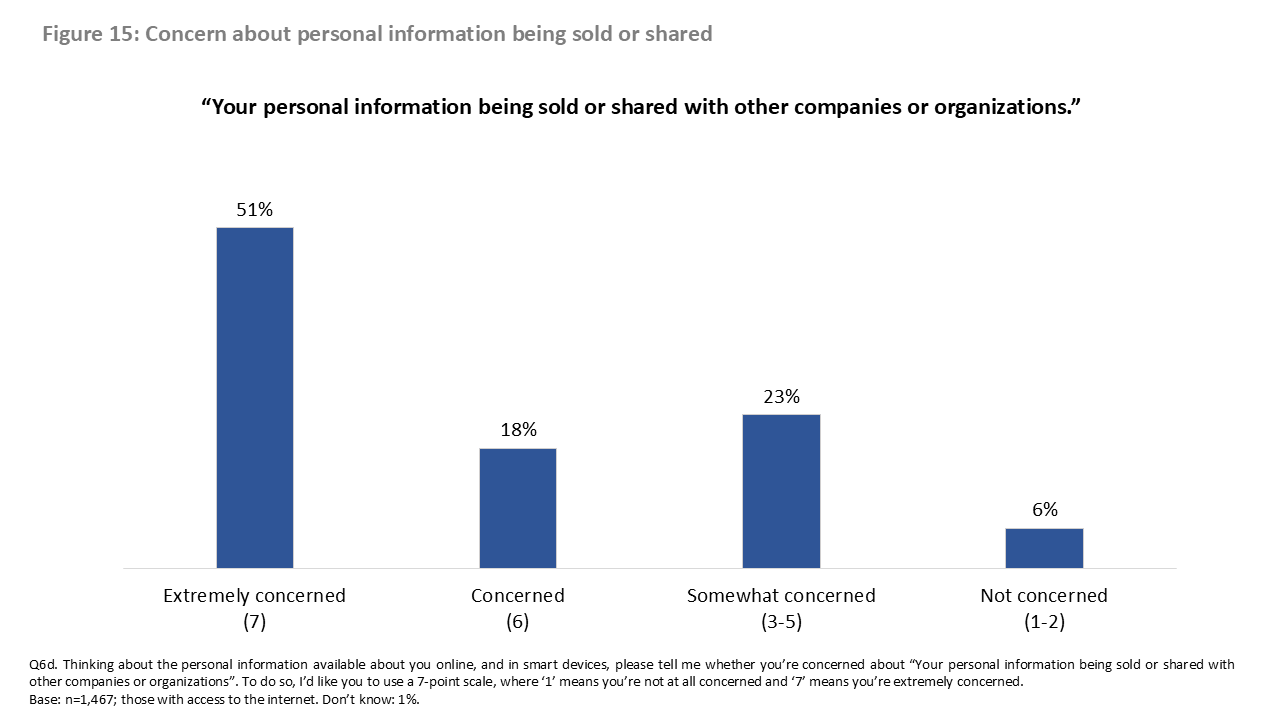
Text version of Figure 15
Figure 15: Concern about personal information being sold or shared
Q6d. Thinking about the personal information available about you online, and in smart devices, please tell me whether you’re concerned about “Your personal information being sold or shared with other companies or organizations”. To do so, I’d like you to use a 7-point scale, where ‘1’ means you’re not at all concerned and ‘7’ means you’re extremely concerned.
| Level of concern | % of respondents |
|---|---|
| Extremely concerned (7) | 51% |
| Concerned (6) | 18% |
| Somewhat concerned (3-5) | 23% |
| Not concerned (1-2) | 6% |
| Base: n=1,467; those with access to the internet. Don’t know: 1%. | |
Canadians aged 35+ (72% of 35- to 54-year-olds and 75% of those aged 55+), women (73%), college (73%) and university (71%) graduates, Canadians with a disability (79%), and those very concerned about privacy protection (78%) were more likely to be concerned (scores of six and seven) about the selling or sharing of their personal information.
Most are concerned about personal information being used to train AI systems
Almost nine in 10 (88%) Canadians have some level of concern about their personal information being used to train AI systems, including 42% who are extremely concerned. Just 11% are not concerned about their personal information being used to train AI systems.

Text version of Figure 16
Figure 16: Concern about personal information being used to train AI systems
“Your personal information being used to train AI systems.”
Q6e. Thinking about the personal information available about you online, and in smart devices, please tell me whether you’re concerned about “Your personal information being used to train AI systems”. To do so, I’d like you to use a 7-point scale, where ‘1’ means you’re not at all concerned and ‘7’ means you’re extremely concerned.
| Level of concern | % of respondents |
|---|---|
| Extremely concerned (7) | 42% |
| Concerned (6) | 15% |
| Somewhat concerned (3-5) | 31% |
| Not concerned (1-2) | 11% |
| Base: n=1,467; those with access to the internet. Don’t know: 2%. | |
Concern about their personal information being used to train AI systems increased with age, from 28% of 16- to 24-year-olds, to 48% of 25- to 34-year-olds, to 60% of 35- to 54-year-olds, to 65% of those 55 and older. Additionally, Canadians very concerned about the protection of their privacy were more likely to express concern about AI systems and personal information (68%).
1.4 Breaches, Protecting Privacy and Privacy Policies
Nearly half of those surveyed have been impacted by a privacy breach
Approximately four in 10 Canadians (43%) said that they have been affected by a privacy breach. College (42%) and university (48%) graduates, Indigenous Peoples (57%), and Canadians very concerned about the protection of their privacy (47%) were more likely to have been affected by a breach. Additionally, the likelihood of having been impacted generally increased with household income, from 31% of those with incomes under $40,000, to 48% of those with household incomes of $150,000 or above.
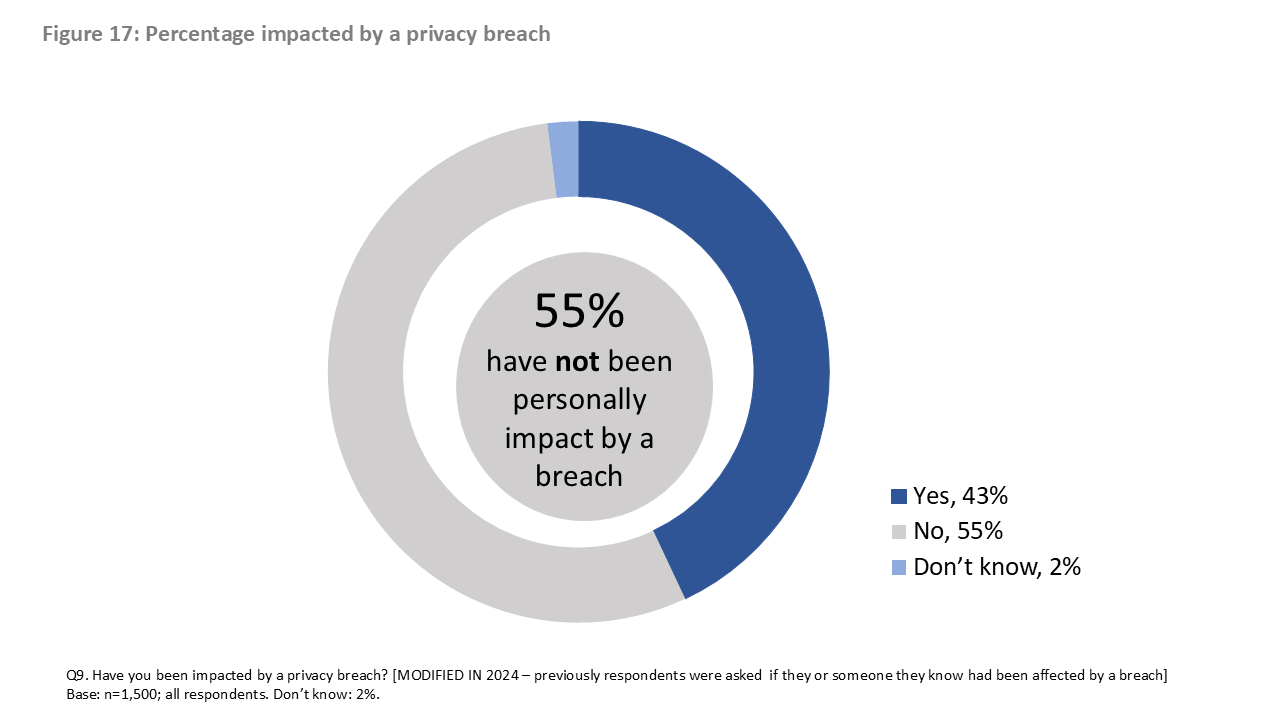
Text version of Figure 17
Figure 17: Percentage impacted by a privacy breach
Q9. Have you been impacted by a privacy breach? [MODIFIED IN 2024 – previously respondents were asked if they or someone they know had been affected by a breach]
| Impacted by privacy breach | % of respondents |
|---|---|
| Yes | 43% |
| No | 55% |
| Don’t know | 2% |
| Base: n=1,500; all respondents. Don’t know: 2%. | |
Fifty-five percent of surveyed Canadians said that they have not been impacted by a privacy breach. Regionally, residents of Quebec (60%) were more likely than residents of Atlantic Canada (50%) and Ontario (52%) to have not been impacted by a privacy breach.
Most Canadians have taken action to protect their privacy
Nine in 10 (92%) Canadians have taken at least one action to protect their personal information. More than three-quarters (78%) of respondents have refused to provide an organization or business their personal information due to privacy concerns, while exactly three-quarters (75%) have adjusted their privacy settings on a social media account. Following this, two-thirds (67%) have adjusted privacy settings for other online or mobile app accounts. Additionally, just over half (52%) have deleted or stopped using an account because of privacy concerns, and 41% have stopped doing business with a company that experienced a privacy breach.
The only noteworthy change since 2022 is the proportion of Canadians refusing to provide their personal information, which has increased from 74% in 2022 to 78% in 2024.

Text version of Figure 18
Figure 18: Actions taken to protect privacy
*In previous years, respondents were asked about a ‘social media’ account.
Q7. The following questions focus on actions you may have taken when it comes to your personal information. Have you:… ?
| Actions | 2020 | 2022 | 2024 |
|---|---|---|---|
| Refused to provide personal information because of privacy concerns | 74% | 78% | |
| Adjusted privacy settings on social media account | 74% | 75% | 75% |
| Adjusted privacy settings for other online or mobile app accounts | 67% | ||
| Deleted or stopped using an account because of privacy concern* | 41% | 50% | 52% |
| Stopped doing business with a company that experienced a privacy breach | 40% | 38% | 41% |
| Base: those for whom the scenario applies. Don’t know ranged from <0.5% to 2%. | |||
The strongest trend related to age and overall privacy concern. Canadians aged 65+ were less likely than younger Canadians to adjust privacy settings on social media (51%) or other online/mobile apps (43%), delete or stop using an account (47%), refuse to provide personal information (72%), or stop doing business with a company after a privacy breach (34%). Those who were very concerned about their privacy were more likely to take all these actions.
The majority of Canadians find privacy policies difficult to understand
Seven in 10 (71%) surveyed Canadians find it somewhat (42%) or very (29%) difficult to understand privacy policies. In contrast, a little more than one-quarter do not: 19% find it somewhat easy and 9% very easy.

Text version of Figure 19
Figure 19: Ease of understanding privacy policies
Q8a. Would you say it is very easy, somewhat easy, somewhat difficult or very difficult to [READ ITEM]?
| Level of understanding | % of respondents |
|---|---|
| Very easy | 9% |
| Somewhat easy | 19% |
| Somewhat difficult | 42% |
| Very difficult | 29% |
| Base: n=1,467; those with access to the internet. Don’t know: 1%. | |
Canadians 16- to 24-years of age (52%), those who are part of a racialized community (39%) and those who are very knowledgeable about how to protect their privacy (40%) were more likely to find privacy policies easy to understand.
Five in 10 Canadians find it difficult to change the privacy settings of their online accounts
Just over half of those surveyed said it was somewhat (35%) or very (18%) difficult to change privacy settings on social media, mobile apps, or other types of online accounts. Conversely, 45% found it somewhat or very easy.

Text version of Figure 20
Figure 20: Ease of changing privacy settings
Q8b. Would you say it is very easy, somewhat easy, somewhat difficult or very difficult to [READ ITEM]?
| Level of ease | % of respondents |
|---|---|
| Very easy | 16% |
| Somewhat easy | 29% |
| Somewhat difficult | 35% |
| Very difficult | 18% |
| Base: n=1,467; those with access to the internet. Don’t know: 3%. | |
Canadians aged 16- to 24-year (68%), Indigenous Peoples (60%), and those who are part of a racialized community (52%) were more likely to find it easy to change privacy settings.
1.5 Attitudes on Information Sharing
Three-quarters of Canadians are less willing to share personal information than they were five years ago
Compared to five years ago, three-quarters of those surveyed said that they are somewhat less (28%) or much less (47%) willing to share their personal information with organizations. Most of the rest (20%) said that their willingness to share their personal information is about the same now as it was five years ago. Few respondents (5%) are more willing to share their personal information with organizations.

Text version of Figure 21
Figure 21: Willingness to share personal information with organizations compared to 5 years ago
Q10. Compared to five years ago, how willing are you to share your personal information with organizations?
| Level of willingness | % of respondents |
|---|---|
| Much more willing | 1% |
| Somewhat more willing | 4% |
| About the same | 20% |
| Somewhat less willing | 28% |
| Much less willing | 47% |
| Base: n=1,500; all respondents. | |
Eighty-four percent of Quebec residents are less likely to share their personal information, compared to 74% in Ontario, 70% in the Prairies, and 67% in British Columbia. Willingness to share personal information decreased with age, from 80% of those aged 55 and over to 60% of 16- to 24-year-olds. Canadians concerned about privacy protection and those unfamiliar with how to protect their privacy were also less willing to share their information.
Attitudes towards sharing personal information varied among Canadians
Two-thirds (67%) of Canadians do not know where the personal information that they share online goes, or how it is used. Meanwhile, half (50%) often feel tricked or pressured into giving more personal information than they think is needed to set up an online account, while 43% do not find it easy to delete an online account. That said, fewer respondents are more likely to give extra personal information to get a deal or save money (21%) or in response to pop-ups from websites or apps asking them to do something (14%).
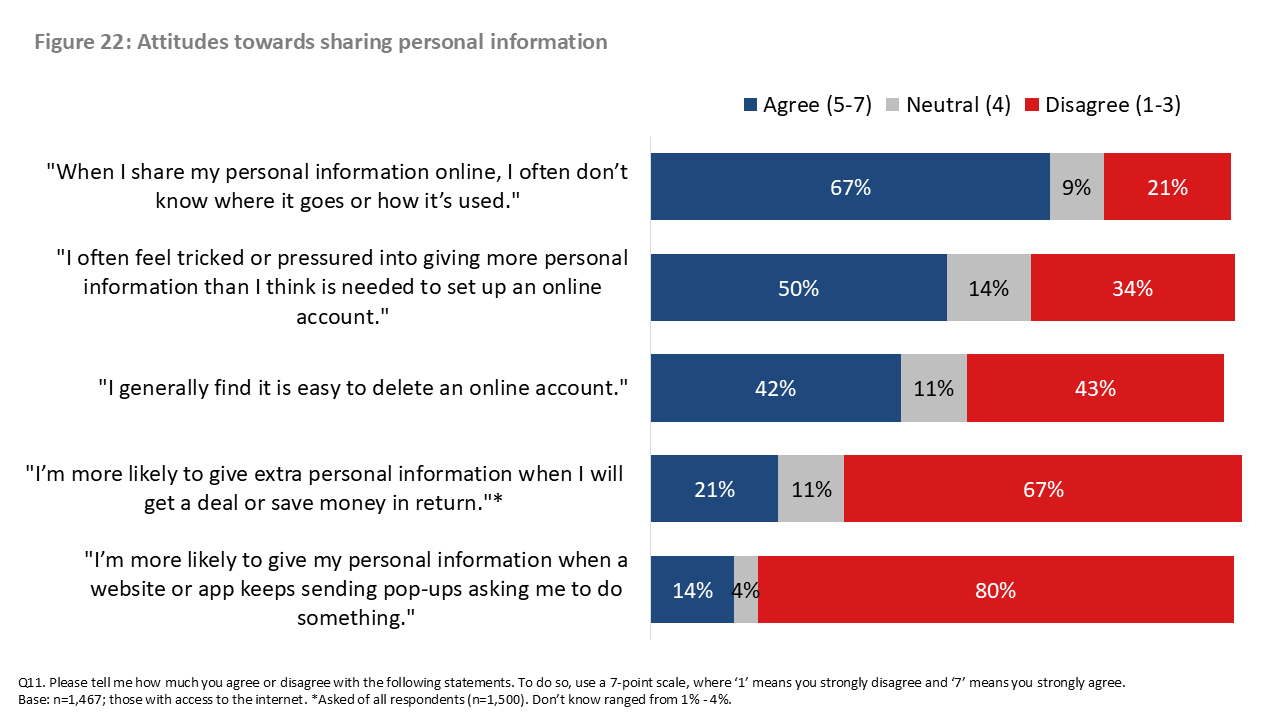
Text version of Figure 22
Figure 22: Attitudes towards sharing personal information
Q11. Please tell me how much you agree or disagree with the following statements. To do so, use a 7-point scale, where ‘1’ means you strongly disagree and ‘7’ means you strongly agree.
| Attitudes | Agree (5-7) | Neutral (4) | Disagree (1-3) |
|---|---|---|---|
| “When I share my personal information online, I often don’t know where it goes or how it’s used." | 67% | 9% | 21% |
| “I often feel tricked or pressured into giving more personal information than I think is needed to set up an online account." | 50% | 14% | 34% |
| “I generally find it is easy to delete an online account." | 42% | 11% | 43% |
| “I’m more likely to give extra personal information when I will get a deal or save money in return."* | 21% | 11% | 67% |
| “I’m more likely to give my personal information when a website or app keeps sending pop-ups asking me to do something." | 14% | 4% | 80% |
| Base: n=1,467; those with access to the internet. *Asked of all respondents (n=1,500). Don’t know ranged from 1% - 4%. | |||
1.6 Awareness of the Privacy Commissioner of Canada and Use of Privacy Resources
One-quarter of Canadians are aware of federal privacy institutions
Twenty-six percent of Canadians said that they are aware of federal institutions that help Canadians deal with privacy and the protection of personal information. The majority (72%) are not aware. Awareness levels have not changed significantly since 2022.

Text version of Figure 23
Figure 23: Awareness of federal institutions that deal with privacy
Q12. Are you aware of any federal institutions that help Canadians deal with privacy and the protection of personal information?
| Year | % of respondents |
|---|---|
| 2022 | 23% |
| 2024 | 26% |
| Base: n=1,500; all respondents; Don’t know: 1%. | |
Awareness of federal privacy institutions was lower in Quebec (15%) while it was higher among university graduates (34%) and Canadians who consider themselves to be very knowledgeable about how to protect their privacy (36%).
Half are aware of the Privacy Commissioner of Canada
When asked if they have heard of the Privacy Commissioner of Canada, respondents were evenly split with half being aware and half not aware.
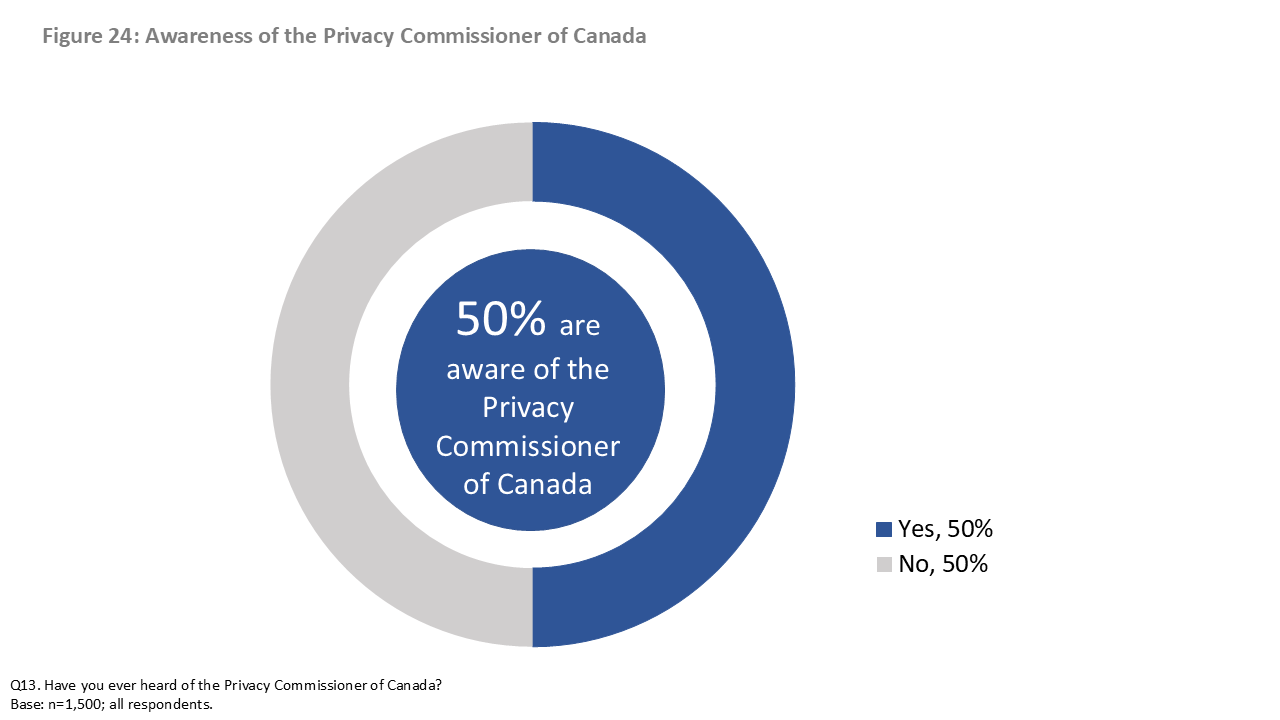
Text version of Figure 24
Figure 24: Awareness of the Privacy Commissioner of Canada
Q13. Have you ever heard of the Privacy Commissioner of Canada?
| Awareness | % of respondents |
|---|---|
| Yes | 50% |
| No | 50% |
| Base: n=1,500; all respondents. | |
Awareness of the Privacy Commissioner of Canada was lower in Quebec (43%), among those who identify as part of a racialized community (32%), Indigenous Peoples (37%), those who with a high school diploma or less education (35%), those not concerned about their privacy (32%), and those not knowledgeable about how to protect their privacy (36%). Additionally, as age increased the likelihood of being aware of the Privacy Commissioner of Canada increased, from 23% of 16- to 24-year-olds, to 65% of those aged 65 and over.
Few Canadians have used the OPC’s privacy resources
When asked if they had ever accessed resources, guidance, or other privacy-related information from the OPC, only 8% of Canadians said that they had. In contrast, 91% reported that they had not.

Text version of Figure 25
Figure 25: Use of OPC resources
Q14. Have you ever obtained resources, guidance or other information about privacy from the OPC?
| Use of OPC resources | % of respondents |
|---|---|
| Yes | 8% |
| No | 91% |
| Don’t know | 1% |
| Base: n=1,500; all respondents. Don’t know: 1%. | |
Nine in 10 Canadians have not made a privacy complaint
The vast majority of Canadians (93%) have never made a privacy complaint about a business or government institution, while 7% have done so.
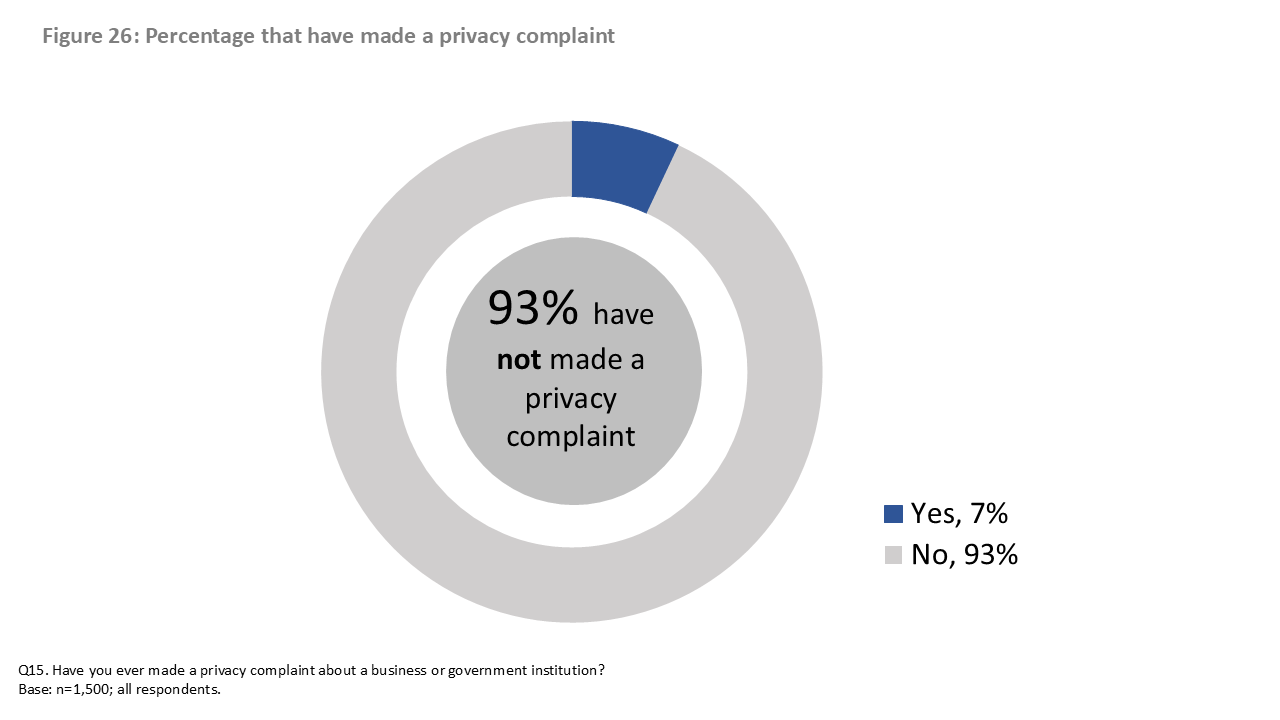
Text version of Figure 26
Figure 26: Percentage that have made a privacy complaint
Q15. Have you ever made a privacy complaint about a business or government institution?
| Made a privacy complaint | % of respondents |
|---|---|
| Yes | 7% |
| No | 93% |
| Base: n=1,500; all respondents. | |
Businesses were the primary institutions that complaints were filed against
Among those who made a privacy complaint (n=106), close to half (44%) filed a formal complaint with a business and approximately one-quarter (23%) did so with a government institution. Eleven percent said that they filed a complaint with a regulatory agency and 8% with the police.
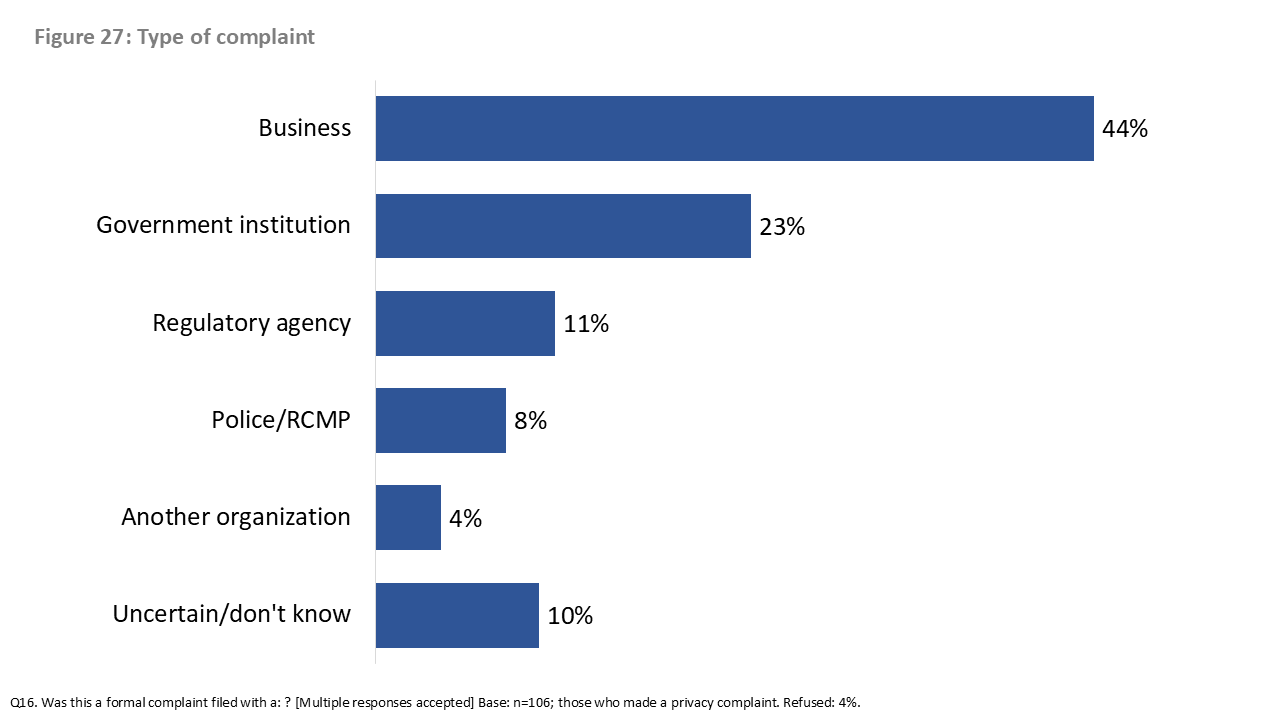
Text version of Figure 27
Figure 27: Type of complaint
Q16. Was this a formal complaint filed with a: ? [Multiple responses accepted]
| Type | % of complaints |
|---|---|
| Business | 44% |
| Government institution | 23% |
| Regulatory agency | 11% |
| Police/RCMP | 8% |
| Another organization | 4% |
| Uncertain/don't know | 10% |
| Base: n=106; those who made a privacy complaint. Refused: 4%. | |
1.7 Communications-related Issues
Canadians are interested in receiving more information on a variety of privacy topics
Canadians were asked which privacy topics they would like more information on. The most common responses were privacy risks and protecting personal information (28%) and online privacy protection (27%). Additionally, 20% wanted information on preventing identity theft and fraud, 17% on what to do if their personal information is exposed in a cyberattack or data breach, and 15% on steps to take if they believe a business or government institution has violated their privacy.
Other topics were mentioned in smaller proportions, as shown in Figure 28, while the largest single proportion (36%) were unsure which topics interested them.
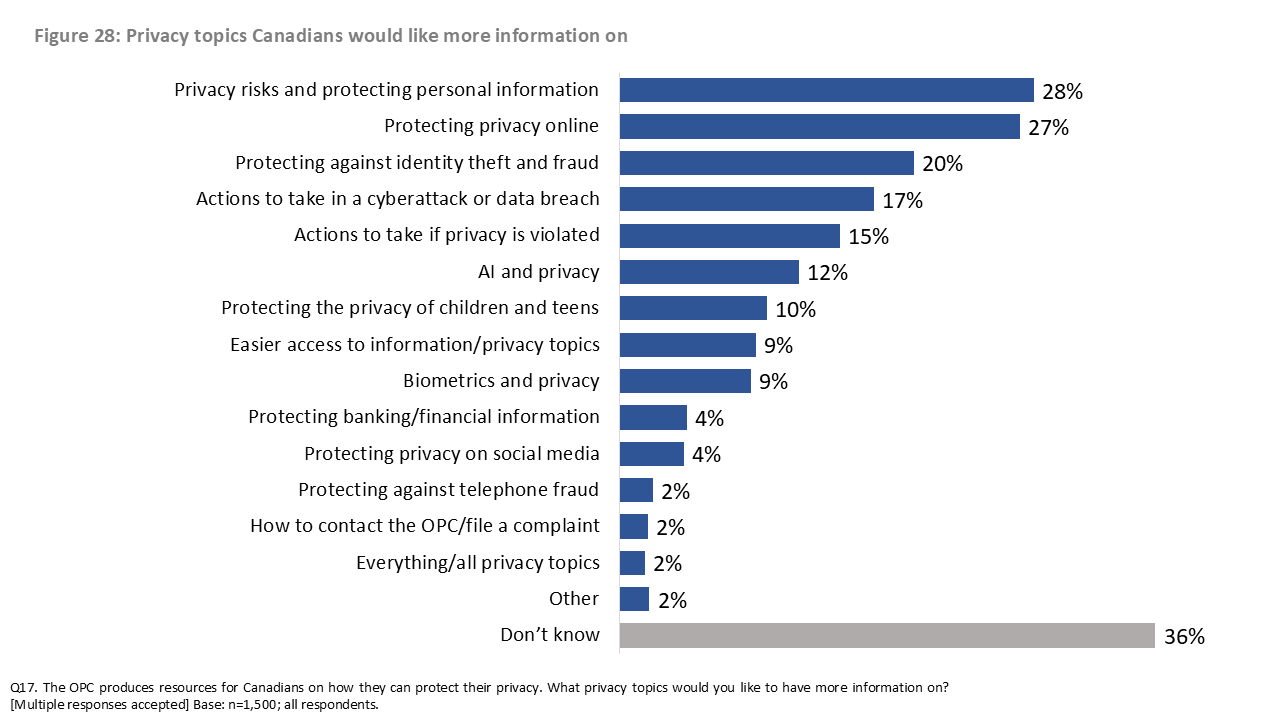
Text version of Figure 28
Figure 28: Privacy topics Canadians would like more information on
Q17. The OPC produces resources for Canadians on how they can protect their privacy. What privacy topics would you like to have more information on? [Multiple responses accepted]
| Privacy topics | % of respondents |
|---|---|
| Privacy risks and protecting personal information | 28% |
| Protecting privacy online | 27% |
| Protecting against identity theft and fraud | 20% |
| Actions to take in a cyberattack or data breach | 17% |
| Actions to take if privacy is violated | 15% |
| AI and privacy | 12% |
| Protecting the privacy of children and teens | 10% |
| Easier access to information/privacy topics | 9% |
| Biometrics and privacy | 9% |
| Protecting banking/financial information | 4% |
| Protecting privacy on social media | 4% |
| Protecting against telephone fraud | 2% |
| How to contact the OPC/file a complaint | 2% |
| Everything/all privacy topics | 2% |
| Other | 2% |
| Don’t know | 36% |
| Base: n=1,500; all respondents. | |
Canadians who identify as a member a racialized community (35%) and those who are very concerned about privacy protection (30%) are more likely to be interested in information on privacy risks and protecting your personal information. Interest in information on protecting privacy online was higher among women (30%), university graduates (32% compared to 20% of those with high school or less education), and Canadians who are very (29%) or somewhat (27%) concerned about their personal privacy.
Most Canadians find privacy information through an internet search
Most Canadians (82%) would conduct an internet search when they need information on a specific topic. Other methods of finding information were mentioned in much smaller proportions as shown in Figure 29.
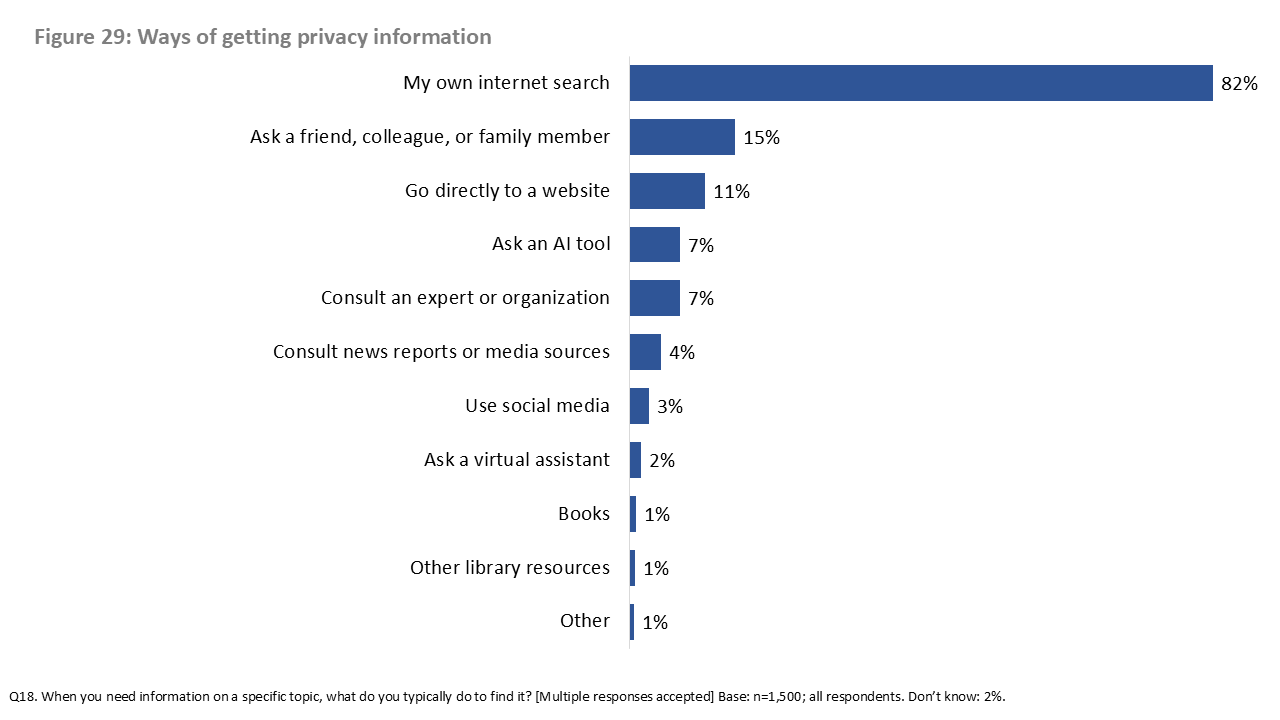
Text version of Figure 29
Figure 29: Ways of getting privacy information
Q18. When you need information on a specific topic, what do you typically do to find it? [Multiple responses accepted]
| Methods | % of respondents |
|---|---|
| My own internet search | 82% |
| Ask a friend, colleague, or family member | 15% |
| Go directly to a website | 11% |
| Ask an AI tool | 7% |
| Consult an expert or organization | 7% |
| Consult news reports or media sources | 4% |
| Use social media | 3% |
| Ask a virtual assistant | 2% |
| Books | 1% |
| Other library resources | 1% |
| Other | 1% |
| Base: n=1,500; all respondents. Don’t know: 2%. | |
Canadians aged 65+ (69%) and those with a disability (69%) were less likely to find information through their own internet search.
2. Online Survey
This section presents the findings from an online survey of parents and teachers, with responses from 302 parents and 109 teachers.
2.1 Parents
2.1.1 Concerns and Views on Risks
The vast majority of parents worry about their children’sFootnote 6 online privacy. In fact, two-thirds or more are moderately to extremely concerned, with 45% highly concerned (scores of very and extremely) about risks to their child from the use or misuse of their personal information. Additionally, 42% are highly concerned about the volume of personal information companies collect about their children, 41% about their children’s use of websites or apps intended for adults, and 37% about the volume of personal information their children share online.

Text version of Figure 30
Figure 30: Concerns about online activities and privacy implications
Q8. Thinking about your child’s (children’s) / teen’s (teens’) online activities, are you concerned about the following?
| Concerns | Not concerned | Slightly concerned | Moderately concerned | Very concerned | Extremely concerned | |
|---|---|---|---|---|---|---|
| The amount of personal information companies collect about your child | 7% | 22% | 27% | 27% | 15% | |
| The amount of personal information your child shares online | 14% | 20% | 28% | 22% | 15% | |
| Your child using websites and mobile apps meant for adults | 11% | 20% | 28% | 22% | 19% | |
| Risks to your child from the use or misuse of their personal information | 7% | 21% | 28% | 25% | 20% | |
| Base: parents, excluding those who said something does not apply to them. Don’t know: 1% or less. | ||||||
Parents were asked to respond to each of these statements based on whether they have a child aged 6-12, or a teen aged 13-17. Those with a child in both cohorts were randomly assigned to respond on behalf of their child or teen. The proportion of parents very or extremely concerned breaks out as follows:
- 35% of parents are concerned about the amount of personal information companies collect about their child and 47% are concerned about the amount collected about their teen
- 31% of parents are concerned about the amount of personal information their child is sharing online, while 40% are concerned about the amount that is being shared by their teen
- 45% of parents are concerned about their child using websites and mobile apps meant for adults and 39% are concerned about their teen using these sites and apps
- 41% of parents are concerned about the potential risks to their child from the use or misuse of their personal information, and 47% are concerned about the risks for their teen
Just over half (55%) of parents think that their child is at least moderately aware of the potential risks associated with sharing personal information online, while 79% of parents think this about their teen.

Text version of Figure 31
Figure 31: Perceptions of child’s/teen’s awareness of the risks of sharing personal information
Q9. How aware do you think your child (children) / teen(s) is of the potential risks of sharing their personal information? For example, sharing it online, with mobile apps, on social media, on gaming platforms or with businesses?
| Level of perception | Teen | Child |
|---|---|---|
| Not aware | 2% | 21% |
| Slightly aware | 18% | 23% |
| Moderately aware | 42% | 25% |
| Very aware | 28% | 26% |
| Extremely aware | 9% | 4% |
| Base: n=302; parents. Don’t know: 2%. | ||
2.1.2 Responsibility for Protecting their Child’s Privacy
Three quarters of parents (74%) see themselves as primarily responsible for protecting the privacy of children and teenagers. This was followed by companies (13%), government (6%), and children and teenagers themselves (4%).
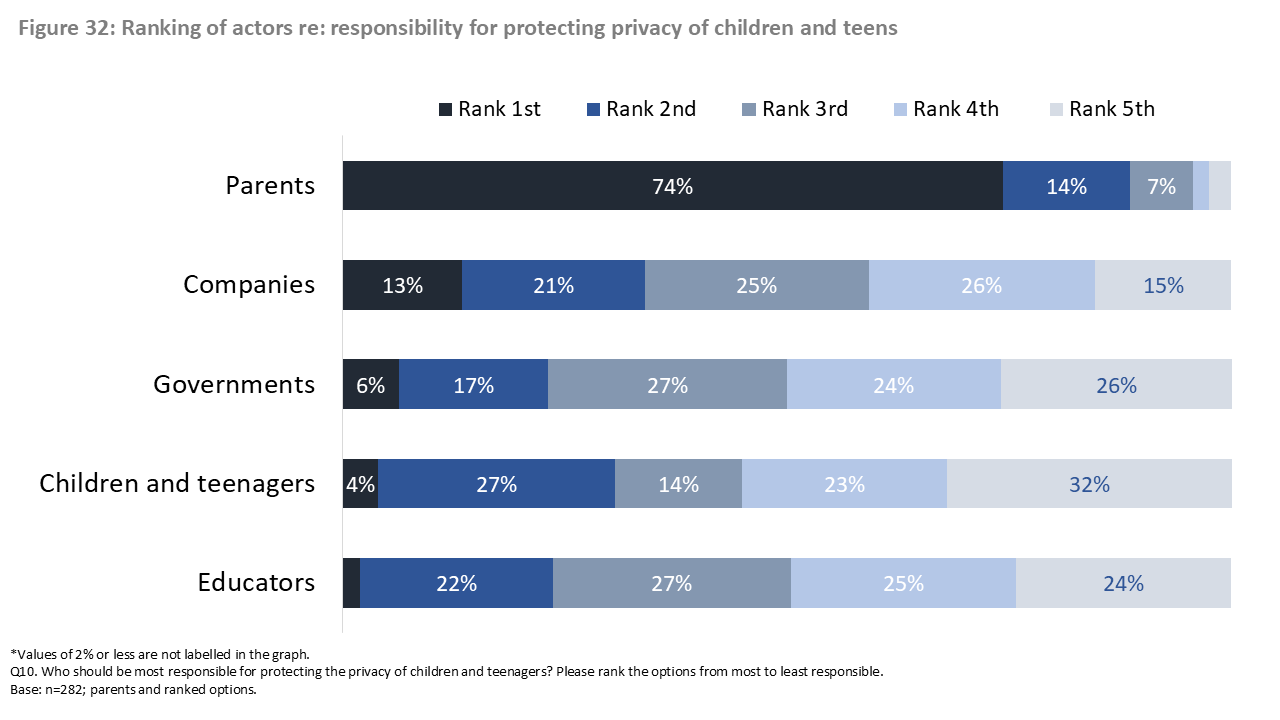
Text version of Figure 32
Figure 32: Ranking of actors re: responsibility for protecting privacy of children and teens
Q10. Who should be most responsible for protecting the privacy of children and teenagers? Please rank the options from most to least responsible.
| Actors | Rank 1st | Rank 2nd | Rank 3rd | Rank 4th | Rank 5th |
|---|---|---|---|---|---|
| Parents | 74% | 14% | 7% | 2% | 3% |
| Companies | 13% | 21% | 25% | 26% | 15% |
| Governments | 6% | 17% | 27% | 24% | 26% |
| Children and teenagers | 4% | 27% | 14% | 23% | 32% |
| Educators | 2% | 22% | 27% | 25% | 24% |
| *Values of 2% or less are not labelled in the graph. | |||||
| Base: n=282; parents and ranked options. | |||||
Parents not only see themselves as responsible for protecting the privacy of children and teenagers, but most feel very or extremely responsible for guiding their child (92%) and teen (84%) in making safe online choices.

Text version of Figure 33
Figure 33: Perceived responsibility for guiding child/teen in making safe online decisions
Q11. How responsible do you feel as a parent for guiding your child (children) / teen(s) in making safe online decisions and protecting their privacy?
| Level of responsibility | Teen | Child |
|---|---|---|
| Not responsible | 1% | 1% |
| Slightly responsible | 2% | 2% |
| Moderately responsible | 13% | 3% |
| Very responsible | 44% | 34% |
| Extremely responsible | 40% | 58% |
| Base: n=302; parents. Don’t know: 1%. | ||
2.1.3 Parental Involvement
Most parents believe that they should be involved in their child’s (90%) and teen’s (74%) online activities, such as setting up email, social media, or other accounts.

Text version of Figure 34
Figure 34: Views on parental involvement in their child/teen’s online activities
Q12. Should parents be involved in their child(dren’s) / teen(s’) online activities, such as setting up an email, social media or other online account?
| Level of parental involvement | Child | Teen |
|---|---|---|
| Parents should be involved | 90% | 74% |
| Parents should not be involved | 1% | 1% |
| It depends | 7% | 24% |
| Base: n=302; parents. Don’t know: 1%. | ||
Nine in 10 parents (92%) reported having discussed the protection of personal information with their teen and three-quarters (75%) have done so with their child.
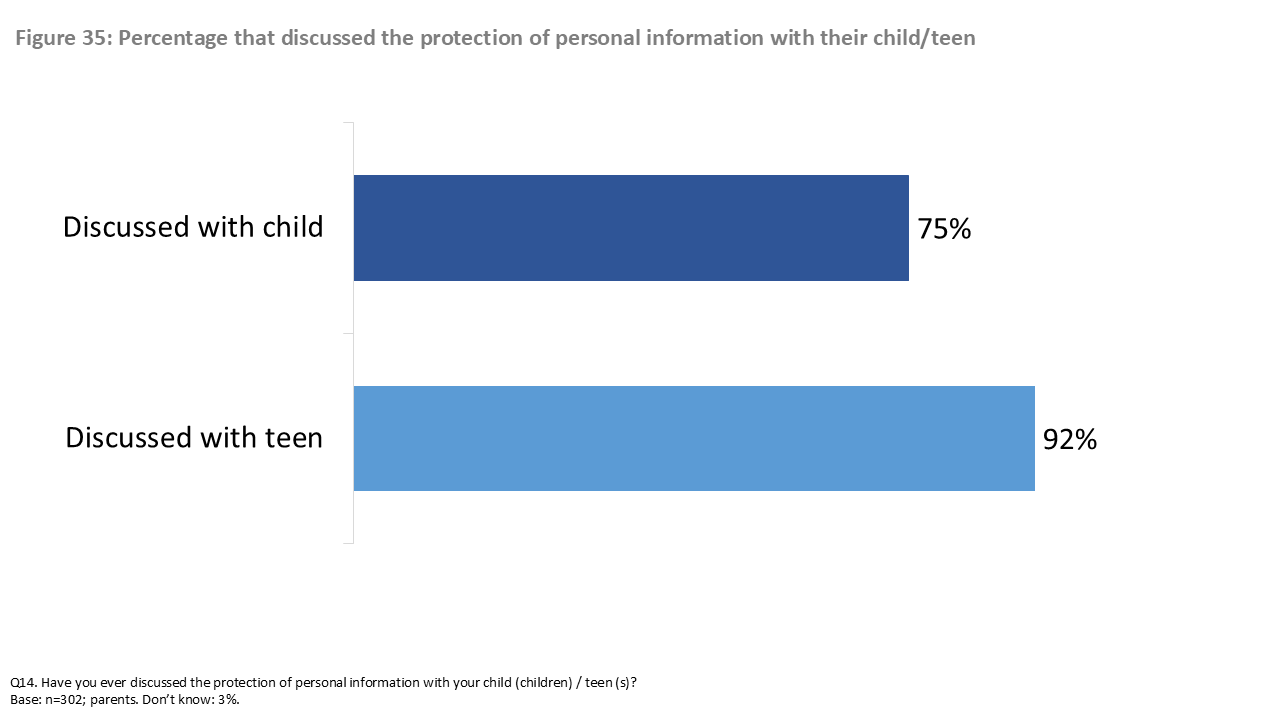
Text version of Figure 35
Figure 35: Percentage that discussed the protection of personal information with their child/teen
Q14. Have you ever discussed the protection of personal information with your child (children) / teen (s)?
| Discussion of protection of personal information | % of respondents |
|---|---|
| Discussed with child | 75% |
| Discussed with teen | 92% |
| Base: n=302; parents. Don’t know: 3%. | |
Two-thirds of parents rated themselves as very or extremely capable of discussing personal information protection with their child (68%) or teen (65%).

Text version of Figure 36
Figure 36: Self-assessed ability to discuss the protection of personal information with their child/teen
Q15. How capable did you feel discussing the protection of personal information with your child (children) / teen (s)?
| Ability to discuss protection of personal information | Teen | Child |
|---|---|---|
| Not capable | 0% | 0% |
| Slightly capable | 7% | 10% |
| Moderately capable | 27% | 21% |
| Very capable | 38% | 42% |
| Extremely capable | 27% | 26% |
| Base: n=252; parents who discussed protection of personal information with their child/teen. | ||
Parents who have not discussed the protection of personal information with their child or teen (n=61)Footnote 7 see themselves as moderately (27%) to highly capable (58%) in this area.
Nearly half (45%) of parents said that they discuss privacy and the protection of personal information with their child/teen at least once a month, while an additional 13% said that they do so weekly. Meanwhile, 33% have these conversations two to three times a year, and 9% do so once a year or less. The frequency of discussing the protection of personal information was similar between age cohorts: 59% of parents with 6- to 12-year-olds said that they discuss this monthly or weekly and 57% of parents with 12- to 17-year-olds said the same.

Text version of Figure 37
Figure 37: Frequency of discussing the protection of personal information with their child/teen
Q16. How often do you discuss privacy and the protection of personal information with your child (children) / teen (s)?
| Frequency | % of respondents |
|---|---|
| At least once a week | 13% |
| At least once a month | 45% |
| 2 or 3 times a year | 33% |
| Once a year or less | 9% |
| Base: n=252; parents who discussed protection of personal information with their child/teen. | |
Parents who have discussed privacy and the protection of personal information with their child or teen (n=252) have covered a variety of topics. Sixty-eight percent have discussed online scams, 63% oversharing information online, 62% cyberbullying, online impersonation, and snooping, and 61% privacy on social media. The full list of topics can be found in Figure 38.
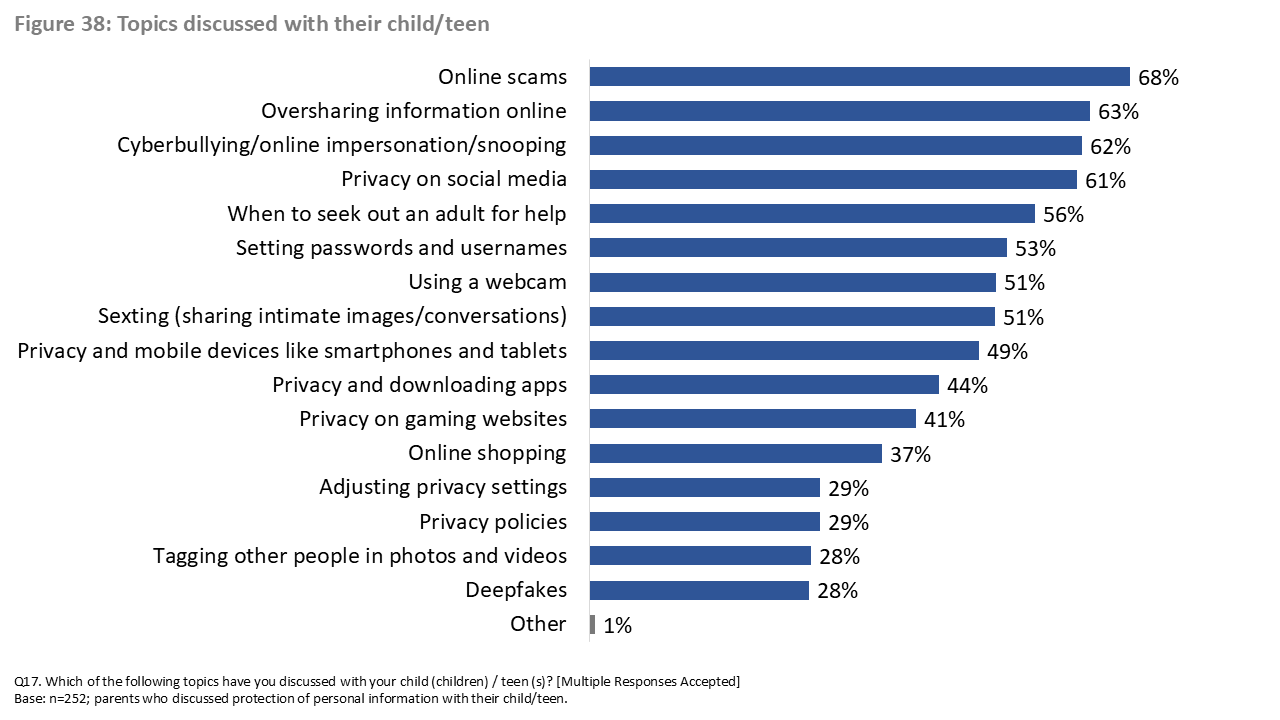
Text version of Figure 38
Figure 38: Topics discussed with their child/teen
Q17. Which of the following topics have you discussed with your child (children) / teen (s)? [Multiple Responses Accepted]
| Topics | % of respondents |
|---|---|
| Online scams | 68% |
| Oversharing information online | 63% |
| Cyberbullying/online impersonation/snooping | 62% |
| Privacy on social media | 61% |
| When to seek out an adult for help | 56% |
| Setting passwords and usernames | 53% |
| Using a webcam | 51% |
| Sexting (sharing intimate images/conversations) | 51% |
| Privacy and mobile devices like smartphones and tablets | 49% |
| Privacy and downloading apps | 44% |
| Privacy on gaming websites | 41% |
| Online shopping | 37% |
| Adjusting privacy settings | 29% |
| Privacy policies | 29% |
| Tagging other people in photos and videos | 28% |
| Deepfakes | 28% |
| Other | 1% |
| Base: n=252; parents who discussed protection of personal information with their child/teen. | |
2.1.4 Views on Businesses and their Child’s Privacy
Almost half of parents (45%) do not have much trust in companies to protect the personal information of young people, while an additional 29% reported having no trust at all.
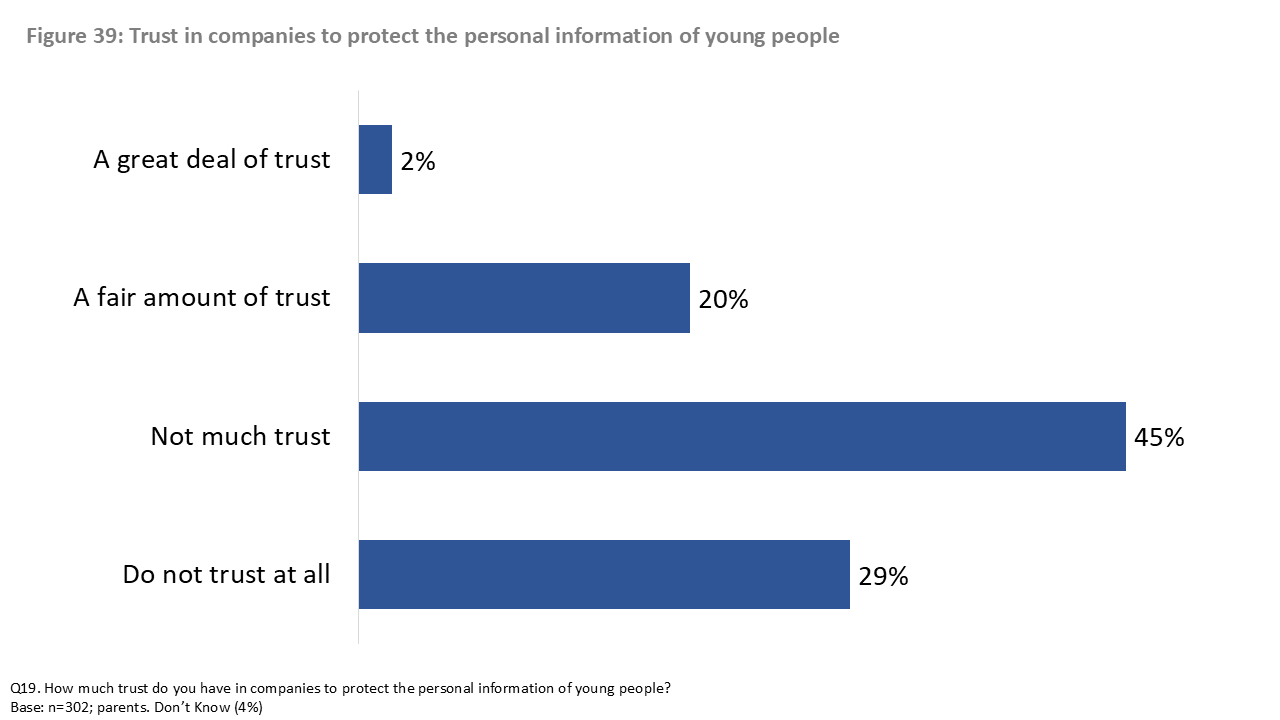
Text version of Figure 39
Figure 39: Trust in companies to protect the personal information of young people
Q19. How much trust do you have in companies to protect the personal information of young people?
| Level of trust | % of respondents |
|---|---|
| Do not trust at all | 29% |
| Not much trust | 45% |
| A fair amount of trust | 20% |
| A great deal of trust | 2% |
| Base: n=302; parents. Don’t Know (4%) | |
2.1.5 Views on Privacy Practices and Parental Controls
Most parents consider the privacy practices of different services at least some of the time before allowing their child or teen to use them.

Text version of Figure 40
Figure 40: Frequency of considering the privacy practices of services used by their child/teen
Q20. How often do you consider the privacy practices of the following services before allowing your child (children) / teen (teens) to use them?
| Services | Always | Sometimes | Never |
|---|---|---|---|
| Websites | 43% | 46% | 7% |
| Mobile apps | 43% | 44% | 9% |
| Gaming platforms | 41% | 41% | 13% |
| Smart devices, like phones and watches | 40% | 46% | 9% |
| Educational platforms | 28% | 48% | 19% |
| Base: n=302; parents. Don’t know (4%-6%) | |||
For the following services, the percentage of parents who said that they always consider privacy practices differed based on whether they parent a child or teen:
- 50% of parents always consider the privacy practices of websites before letting their child use them, while 37% of parents of teens said the same.
- 47% of parents always consider the privacy practices of mobile apps before letting their child use them, while 41% of parents of teens said the same
- 46% of parents always consider the privacy practices of gaming platforms before letting their child use them, while 37% of parents of teens said the same
- 30% of parents always consider the privacy practices of educational platforms before letting their child use them, while 28% of parents of teens said the same
- 42% of parents always consider the privacy practices of smartphones before letting their child use them, while 38% of parents of teens said the same
Almost half of parents (45%) sometimes apply parental controls where available, while 35% do so always.
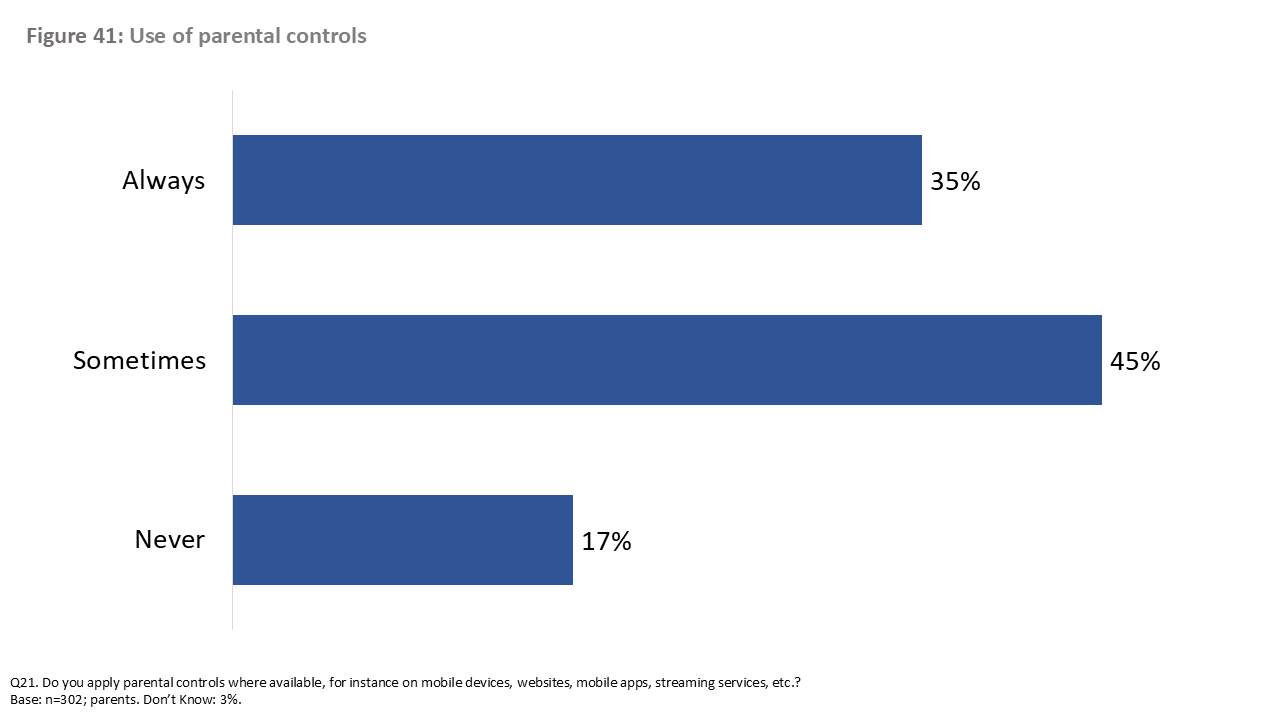
Text version of Figure 41
Figure 41: Use of parental controls
Q21. Do you apply parental controls where available, for instance on mobile devices, websites, mobile apps, streaming services, etc.?
| Frequency | % of respondents |
|---|---|
| Always | 35% |
| Sometimes | 45% |
| Never | 17% |
| Base: n=302; parents. Don’t Know: 3%. | |
Among those who never apply parental controls (n=63), the top reason was not liking them (29%).

Text version of Figure 42
Figure 42: Reasons for not applying parental controls
Q22. Why do you never apply parental controls?
| Reasons | % of respondents |
|---|---|
| Don’t like parental controls | 29% |
| Don’t have time to figure out how to use parental controls | 20% |
| Don’t know how to use parental controls | 16% |
| Trust child/teen | 15% |
| Don’t need them | 10% |
| Didn’t know about parental controls | 3% |
| Some other reason | 15% |
| Base: n=63; parents who never apply parental controls. Don’t Know: 8%. | |
2.1.6 Awareness of the Privacy Commissioner of Canada and Use of Resources
Relatively few parents (18%) are aware of any programs or resources that teach kids or teens about data privacy and safe online practices.
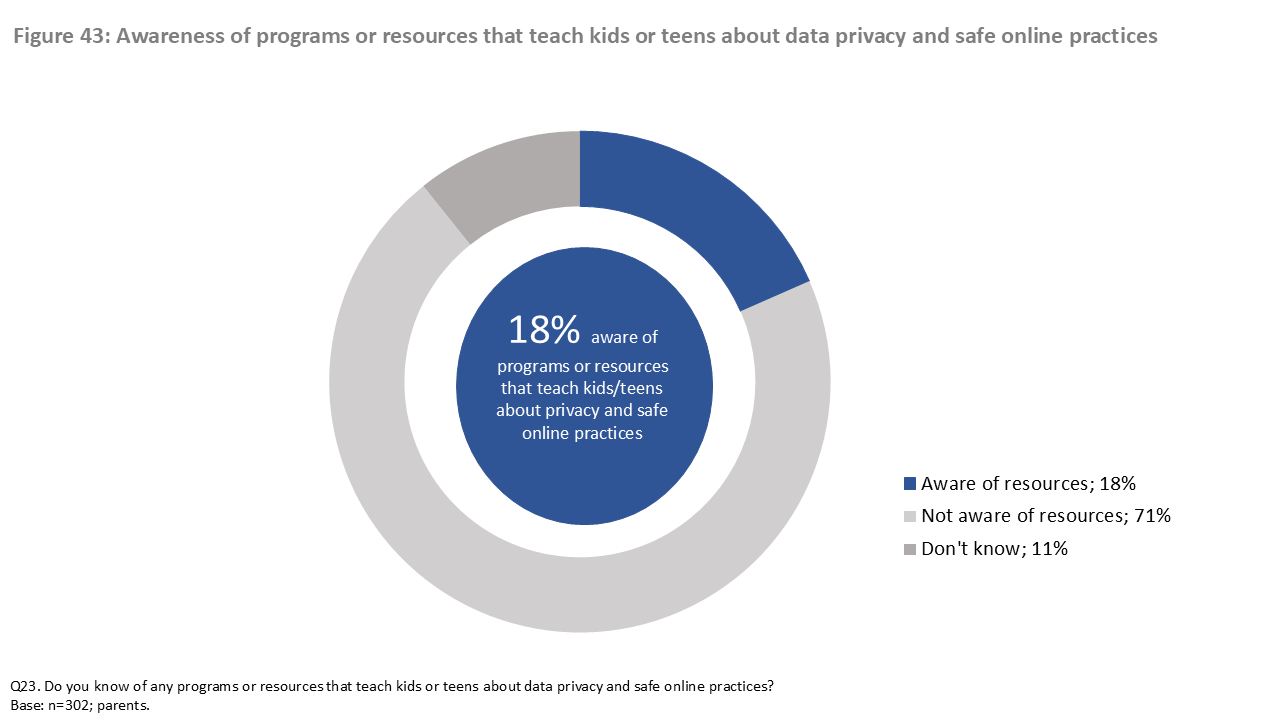
Text version of Figure 43
Figure 43: Awareness of programs or resources that teach kids or teens about data privacy and safe online practices
Q23. Do you know of any programs or resources that teach kids or teens about data privacy and safe online practices?
| Level of awareness | % of respondents |
|---|---|
| Aware of resources | 18% |
| Not aware of resources | 71% |
| Don’t know | 11% |
| Base: n=302; parents. | |
Seven percent of parents are aware of federal institutions that help Canadians deal with privacy and the protection of personal information. Significantly more (39%) are aware of the Privacy Commissioner of Canada.
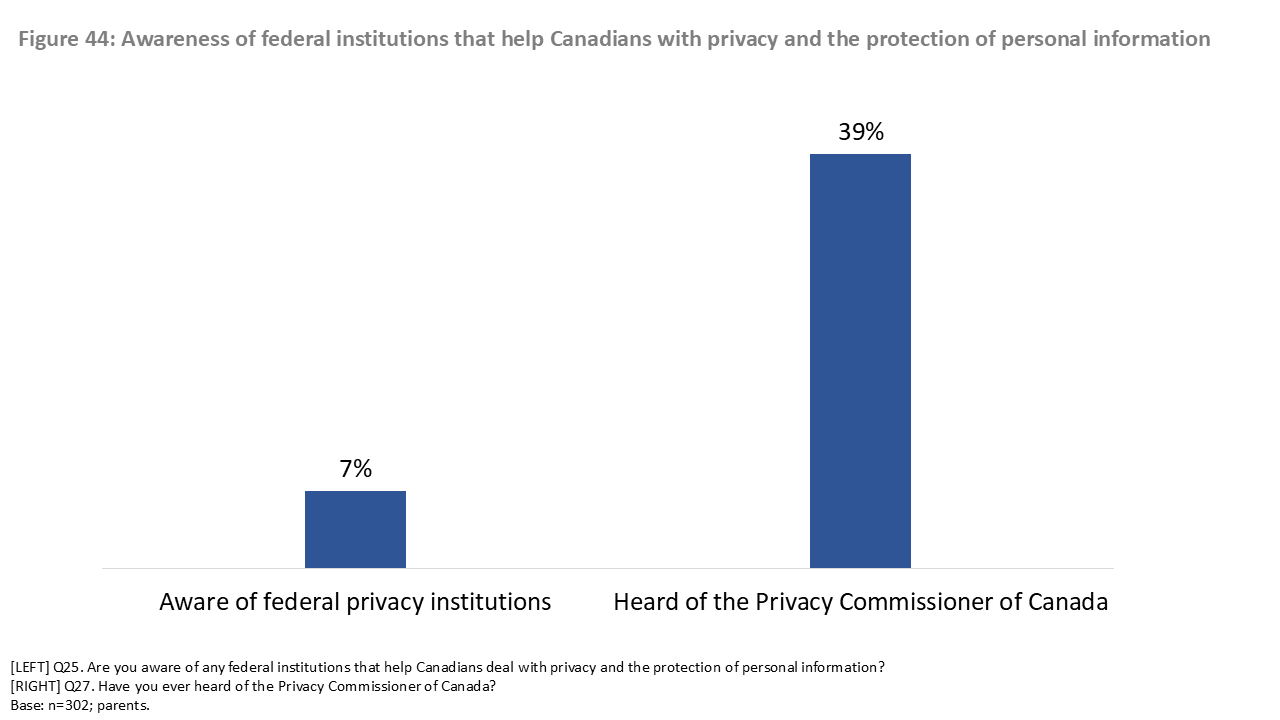
Text version of Figure 44
Figure 44: Awareness of federal institutions that help Canadians with privacy and protection of personal information
[LEFT] Q25. Are you aware of any federal institutions that help Canadians deal with privacy and the protection of personal information?
[RIGHT] Q27. Have you ever heard of the Privacy Commissioner of Canada?
| Level of awareness | % of respondents |
|---|---|
| Aware of federal privacy institutions | 7% |
| Heard of the Privacy Commissioner of Canada | 39% |
| Base: n=302; parents. | |
The vast majority of parents have not used any of the OPC’s resources.
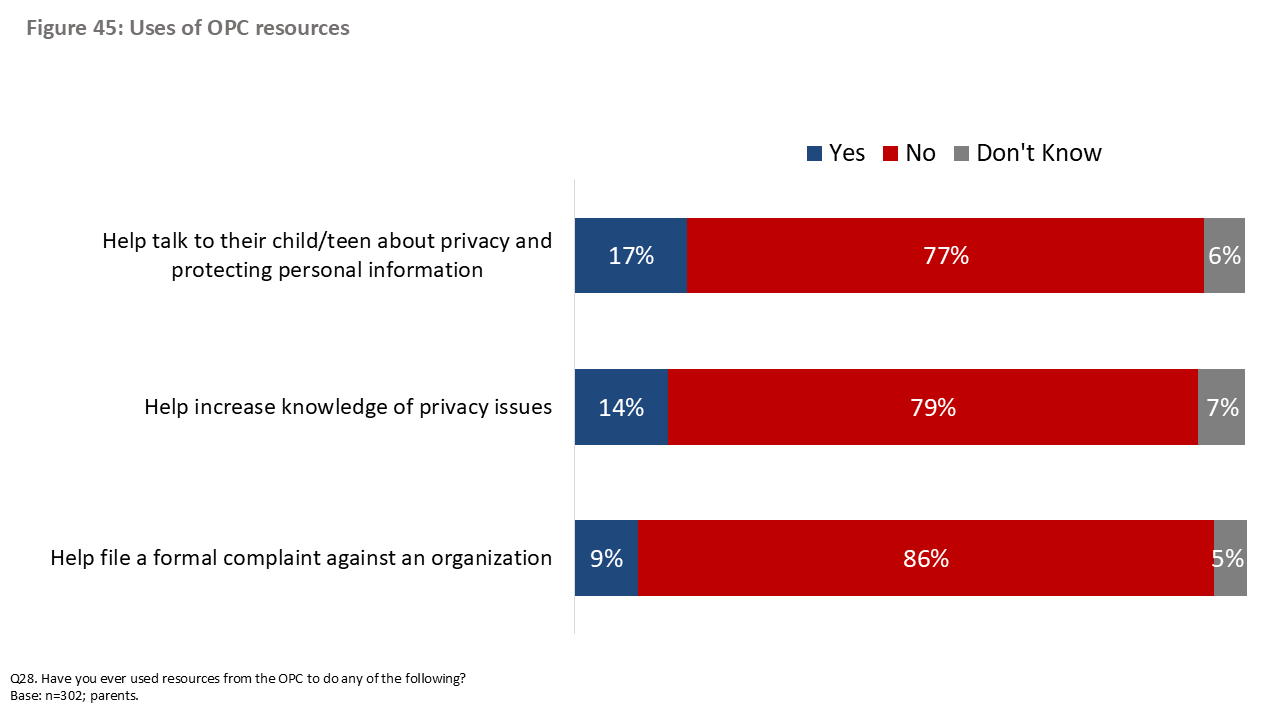
Text version of Figure 45
Figure 45: Uses of OPC resources
Q28. Have you ever used resources from the OPC to do any of the following?
| Uses | Yes | No | Don’t Know |
|---|---|---|---|
| Help talk to their child/teen about privacy and protecting personal information | 17% | 77% | 6% |
| Help increase knowledge of privacy issues | 14% | 79% | 7% |
| Help file a formal complaint against an organization | 9% | 86% | 5% |
| Base: n=302; parents. | |||
2.1.7 Information Needs
As shown in Figure 46, parents would find a variety of topics helpful.
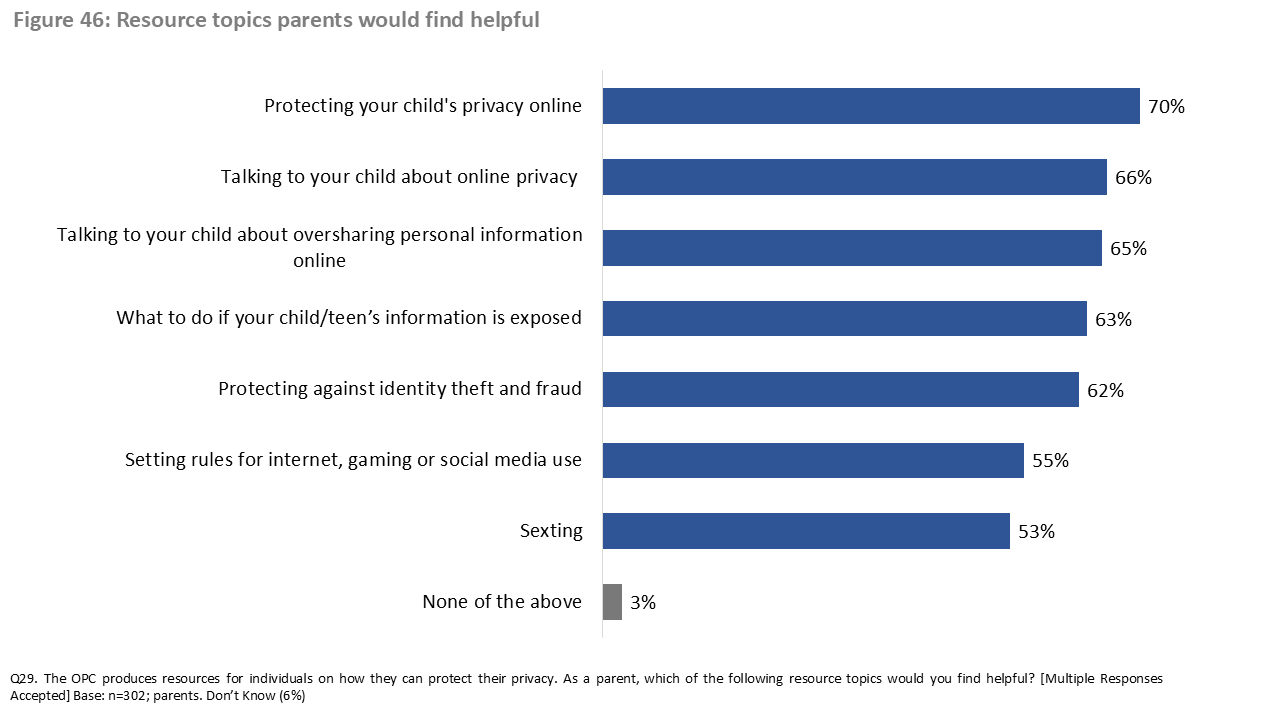
Text version of Figure 46
Figure 46: Resource topics parents would find helpful
Q29. The OPC produces resources for individuals on how they can protect their privacy. As a parent, which of the following resource topics would you find helpful? [Multiple Responses Accepted]
| Topics | % of respondents |
|---|---|
| Protecting your child’s privacy online | 70% |
| Talking to your child about online privacy | 66% |
| Talking to your child about oversharing personal information online | 65% |
| What to do if your child/teen’s information is exposed | 63% |
| Protecting against identity theft and fraud | 62% |
| Setting rules for internet, gaming or social media use | 55% |
| Sexting | 53% |
| None of the above | 3% |
| Base: n=302; parents. Don’t Know (6%) | |
Six in ten parents (64%) reported using an online search engine such as Google to find information on a parenting topic. Moreover, 46% said they ask friends or family members, while 38% visit a website that they believe might have the information they are looking for.
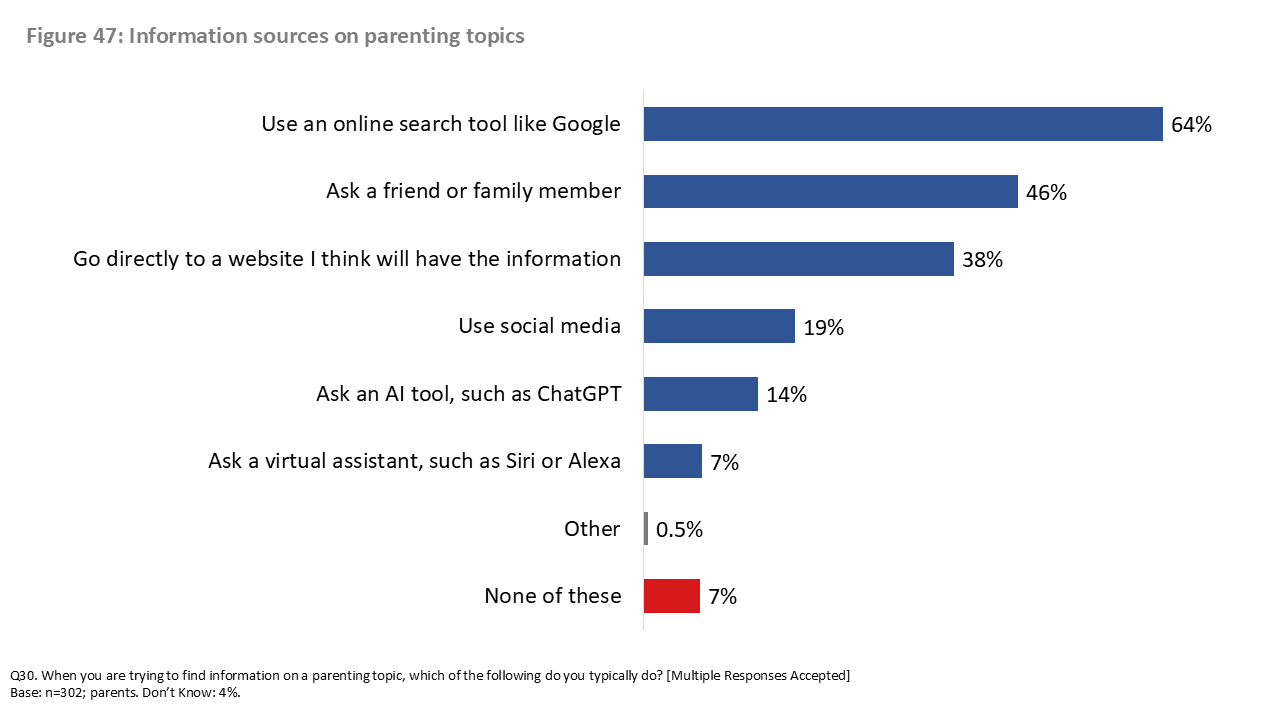
Text version of Figure 47
Figure 47: Information sources on parenting topics
Q30. When you are trying to find information on a parenting topic, which of the following do you typically do? [Multiple Responses Accepted]
| Information sources | % of respondents |
|---|---|
| Use an online search tool like Google | 64% |
| Ask a friend or family member | 46% |
| Go directly to a website I think will have the information | 38% |
| Use social media | 19% |
| Ask an AI tool, such as ChatGPT | 14% |
| Ask a virtual assistant, such as Siri or Alexa | 7% |
| Other | .5% |
| None of these | 7% |
| Base: n=302; parents. Don’t Know: 4%. | |
2.2 Teachers
2.2.1 Grades Taught
Figure 48 shows the grades taught by the teachers included in the survey sample.

Text version of Figure 48
Figure 48: Grades taught
Q31. What grades do you teach? [Multiple Responses Accepted]
| Grades | % of respondents |
|---|---|
| Kindergarten | 13% |
| Grade 1 | 16% |
| Grade 2 | 15% |
| Grade 3 | 17% |
| Grade 4 | 19% |
| Grade 5 | 21% |
| Grade 6 | 23% |
| Grade 7/ Secondary 1 | 23% |
| Grade 8/ Secondary 2 | 20% |
| Grade 9/ Secondary 3 | 27% |
| Grade 10/ Secondary 4 | 32% |
| Grade 11/ Secondary 5 | 27% |
| Grade 12 | 23% |
| Base: n=109; teachers. | |
2.2.2 Concerns and Views on Risks
The majority of teachers have concerns about their students’ online activities.

Text version of Figure 49
Figure 49: Areas of concern about students and privacy
Q32. Thinking about the typical students you work with, are you concerned about the following?
| Areas of concern | Not concerned | Slightly concerned | Moderately concerned | Very concerned | Extremely concerned |
|---|---|---|---|---|---|
| The amount of personal information companies collect about students | 9% | 11% | 26% | 27% | 25% |
| Risks to students from the use or misuse of their personal information | 9% | 15% | 24% | 26% | 25% |
| The amount of personal information students share online | 6% | 11% | 17% | 34% | 27% |
| Students using websites and mobile apps meant for adults | 6% | 10% | 20% | 30% | 30% |
| Base: n=109; teachers. Don’t know: 2%-5%. | |||||
Few teachers (19%) think students understand the long-term consequences of posting material online.
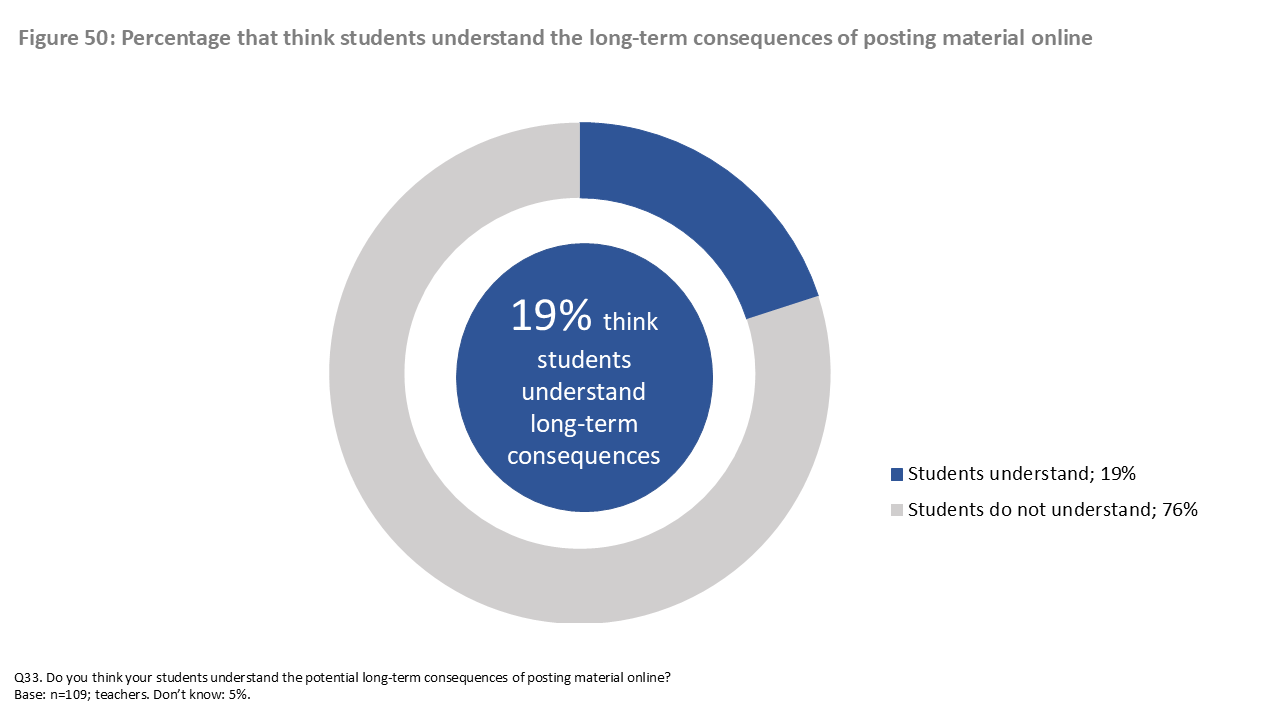
Text version of Figure 50
Figure 50: Percentage that think students understand the long-term consequences of posting material online
Q33. Do you think your students understand the potential long-term consequences of posting material online?
| Level of student understanding | % of respondents |
|---|---|
| Students understand | 19% |
| Students do not understand | 76% |
| Base: n=109; teachers. Don’t know: 5%. | |
Underscoring the fact that most teachers surveyed do not think their students understand the consequences of posting material online, fewer than half (35%) think that their students are at least moderately capable of protecting their privacy online.
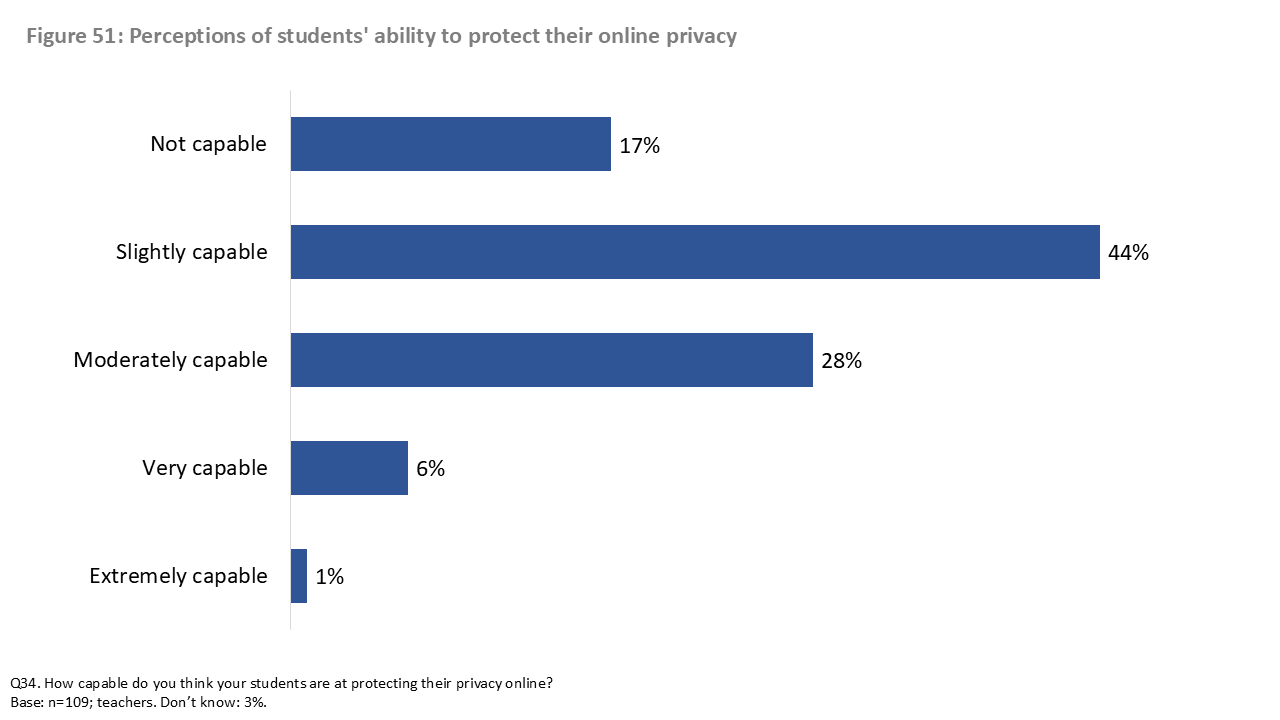
Text version of Figure 51
Figure 51: Perceptions of students’ ability to protect their online privacy
Q34. How capable do you think your students are at protecting their privacy online?
| Perceptions of students’ ability | % of respondents |
|---|---|
| Not capable | 17% |
| Slightly capable | 44% |
| Moderately capable | 28% |
| Very capable | 6% |
| Extremely capable | 1% |
| Base: n=109; teachers. Don’t know: 3%. | |
2.2.3 Responsibility for Protecting Children’s Privacy
Nearly two-thirds of teachers (64%) believe parents are primarily responsible for protecting children’s privacy, while only 3% see educators as the most responsible. The full set of rankings are shown in Figure 52.
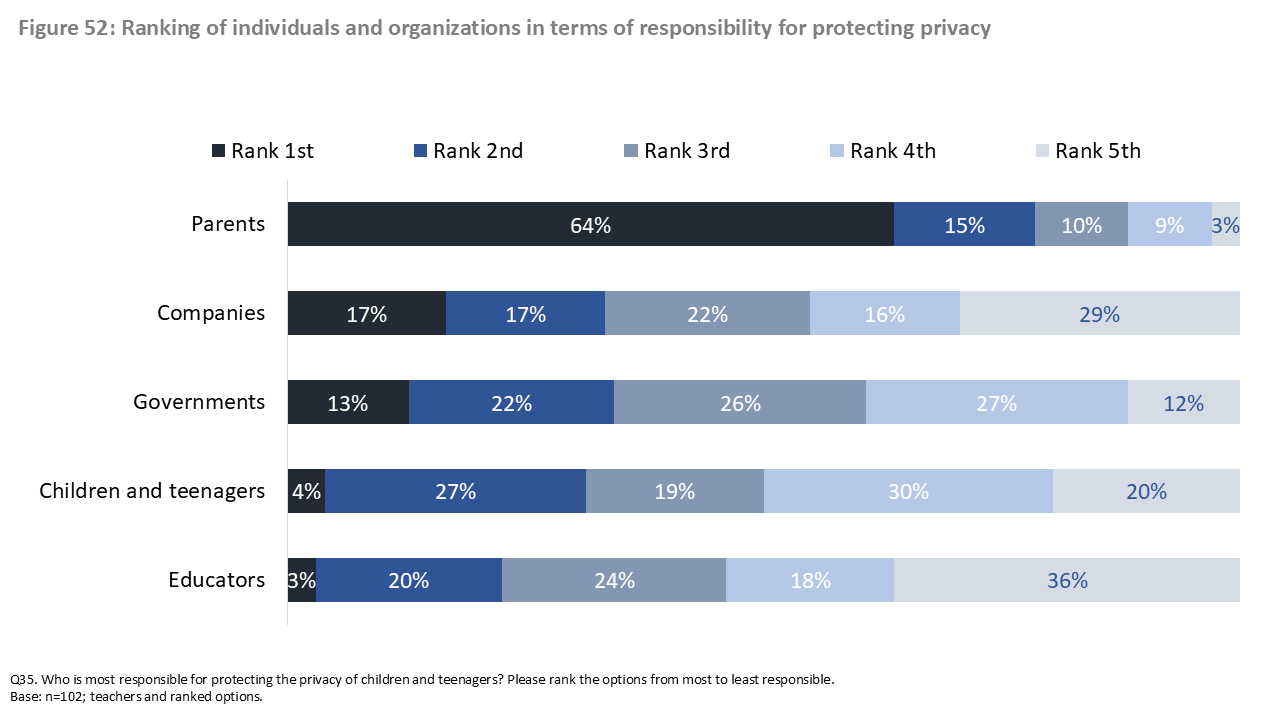
Text version of Figure 52
Figure 52: Ranking of individuals and organizations in terms of responsibility for protecting privacy
Q35. Who is most responsible for protecting the privacy of children and teenagers? Please rank the options from most to least responsible.
| Individuals and organizations | Rank 1st | Rank 2nd | Rank 3rd | Rank 4th | Rank 5th |
|---|---|---|---|---|---|
| Parents | 64% | 15% | 10% | 9% | 3% |
| Companies | 17% | 17% | 22% | 16% | 29% |
| Governments | 13% | 22% | 26% | 27% | 12% |
| Children and teenagers | 4% | 27% | 19% | 30% | 20% |
| Educators | 3% | 20% | 24% | 18% | 36% |
| Base: n=102; teachers and ranked options. | |||||
2.2.4 Personal Privacy and the Classroom
Three-quarters (74%) of the teachers surveyed have discussed privacy and the protection of personal information with their students.
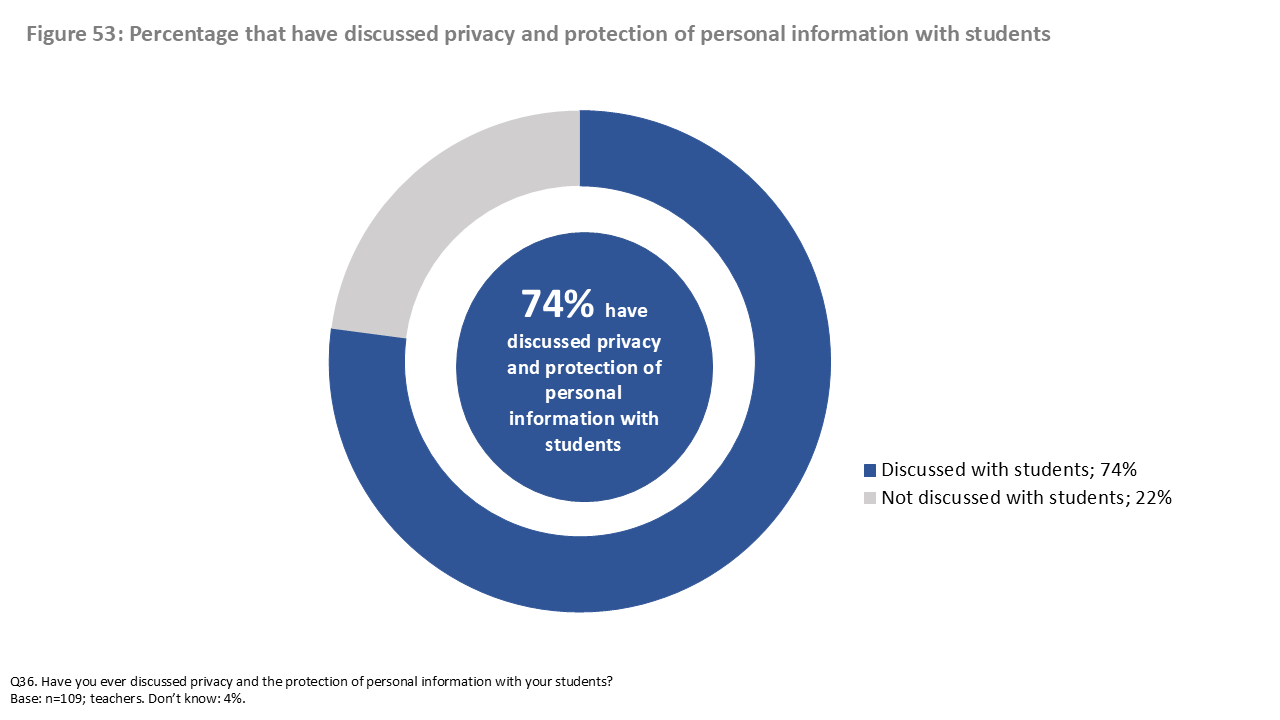
Text version of Figure 53
Figure 53: Percentage that have discussed privacy and protection of personal information with students
Q36. Have you ever discussed privacy and the protection of personal information with your students?
| Level of discussion | % of respondents |
|---|---|
| Discussed with students | 74% |
| Not discussed with students | 22% |
| Base: n=109; teachers. Don’t know: 4%. | |
The vast majority of teachers surveyed who discussed privacy and protection of personal information with their students (n=81) felt at least moderately capable of doing so. Roughly half (48%) felt moderately capable, while four in 10 felt very (31%) or extremely (10%) capable.

Text version of Figure 54
Figure 54: Self-assessed ability to discuss privacy and protection of personal information with students
Q37. How capable did you feel discussing the privacy and protection of personal information with your students?
| Ability to discuss privacy and protection of personal information | % of respondents |
|---|---|
| Not capable | 1% |
| Slightly capable | 10% |
| Moderately capable | 48% |
| Very capable | 31% |
| Extremely capable | 10% |
| Base: n=81; teachers who discussed privacy and protection of personal information with their students. | |
Among the teachers who discussed privacy and protection of personal information with students (n=81), the majority (59%) do so when it fits naturally into classroom discussions. Additionally, 46% use teaching materials, 41% invite experts, and 35% cover it as part of a specific unit.

Text version of Figure 55
Figure 55: Ways of discussing privacy and the protection of personal information matters with students
Q38. How do you discuss matters related to privacy and the protection of personal information with your students? [Multiple Responses Accepted]
| Methods of discussion | % of respondents |
|---|---|
| As part of discussions when it makes sense | 59% |
| Use teaching materials on the subject | 46% |
| Invite experts into the classroom | 41% |
| As part of a specific unit | 35% |
| Base: n=81; teachers who discussed privacy and protection of personal information with their students. | |
Among teachers who have discussed privacy and personal information with their students (n=81), 75% have addressed cyberbullying, online impersonation or snooping, 64% have covered privacy on social media, and over half have discussed oversharing information (56%), webcam use (54%), and online scams (53%). For the full list of topics, see Figure 56.
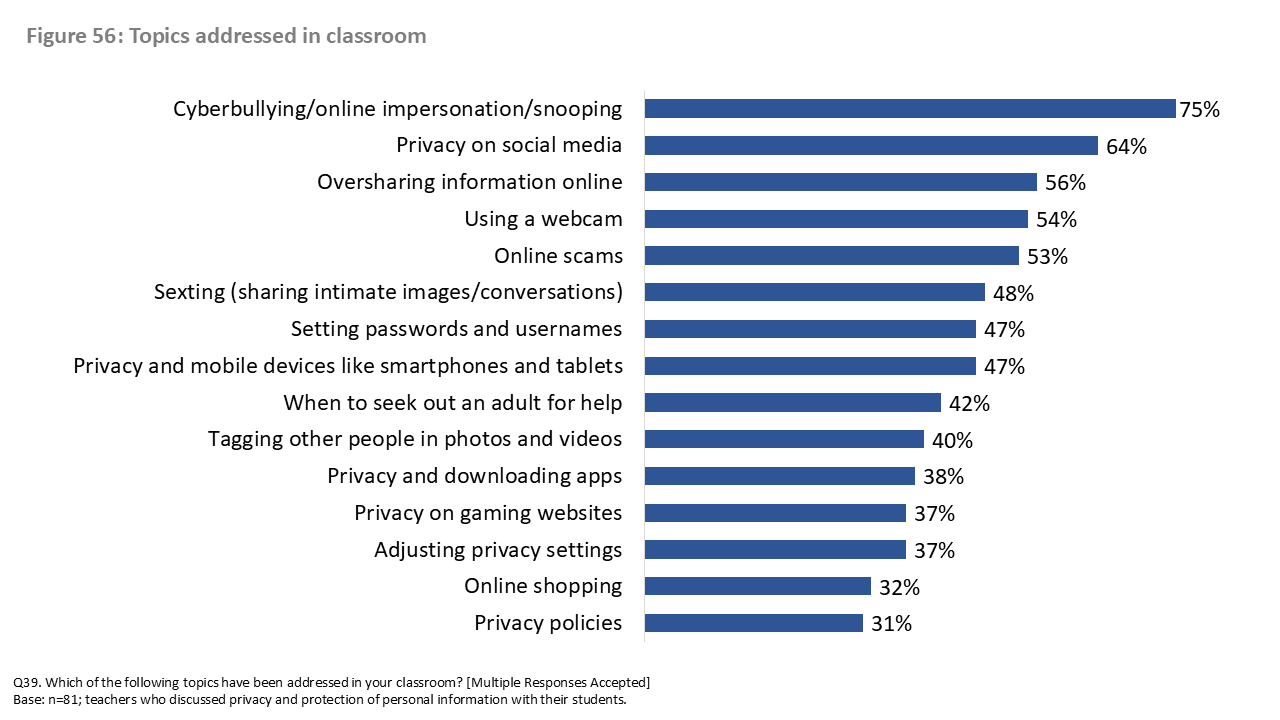
Text version of Figure 56
Figure 56: Topics addressed in classroom
Q39. Which of the following topics have been addressed in your classroom? [Multiple Responses Accepted]
| Topics | % of respondents |
|---|---|
| Cyberbullying/online impersonation/snooping | 75% |
| Privacy on social media | 64% |
| Oversharing information online | 56% |
| Using a webcam | 54% |
| Online scams | 53% |
| Sexting (sharing intimate images/conversations) | 48% |
| Setting passwords and usernames | 47% |
| Privacy and mobile devices like smartphones and tablets | 47% |
| When to seek out an adult for help | 42% |
| Tagging other people in photos and videos | 40% |
| Privacy and downloading apps | 38% |
| Privacy on gaming websites | 37% |
| Adjusting privacy settings | 37% |
| Online shopping | 32% |
| Privacy policies | 31% |
| Base: n=81; teachers who discussed privacy and protection of personal information with their students. | |
Among teachers who did not discuss privacy and the protection of personal information with their students (n=28), most felt moderately or very capable of doing so. The main reason for not covering the topic was that it is not part of the curriculum. A few cited a lack of comfort, lack of knowledge, or insufficient teaching resources. Other reasons, mentioned by a very small number, included the topic not coming up in class and being seen as not important.
2.2.5 Awareness and Use of Resources in the Classroom
Three in 10 (31%) teachers are aware of programs and resources that teach children or teens about privacy and safe online practices.

Text version of Figure 57
Figure 57: Awareness of teaching programs or resources about privacy and safe online practices
Q42. Do you know any programs or resources that teach children or teens about privacy and safe online practices?
| Level of awareness | % of respondents |
|---|---|
| Aware of programs/resources | 31% |
| Not aware of programs/resources | 56% |
| Don’t know | 13% |
| Base: n=109; teachers. | |
Almost six in 10 (57%) surveyed teachers said that they review the privacy practices of educational apps, websites, or web-connected devices before using them in their classroom.

Text version of Figure 58
Figure 58: Percentage that review privacy practices before using educational tools in the classroom
Q44. Do you review the privacy practices of educational apps, websites, or web-connected devices before using them in your classroom?
| Level of review | % of respondents |
|---|---|
| Review privacy practices | 57% |
| Do not review privacy practice | 43% |
| Base: n=109; teachers. | |
Among the teachers who do not review privacy practices (n=47), 36% said it is the school board’s or principal’s responsibility, 26% do not use these resources in their classroom, and 4% lack the time to review them. Additionally, 32% gave no reason for not reviewing the privacy practices of these classroom resources.
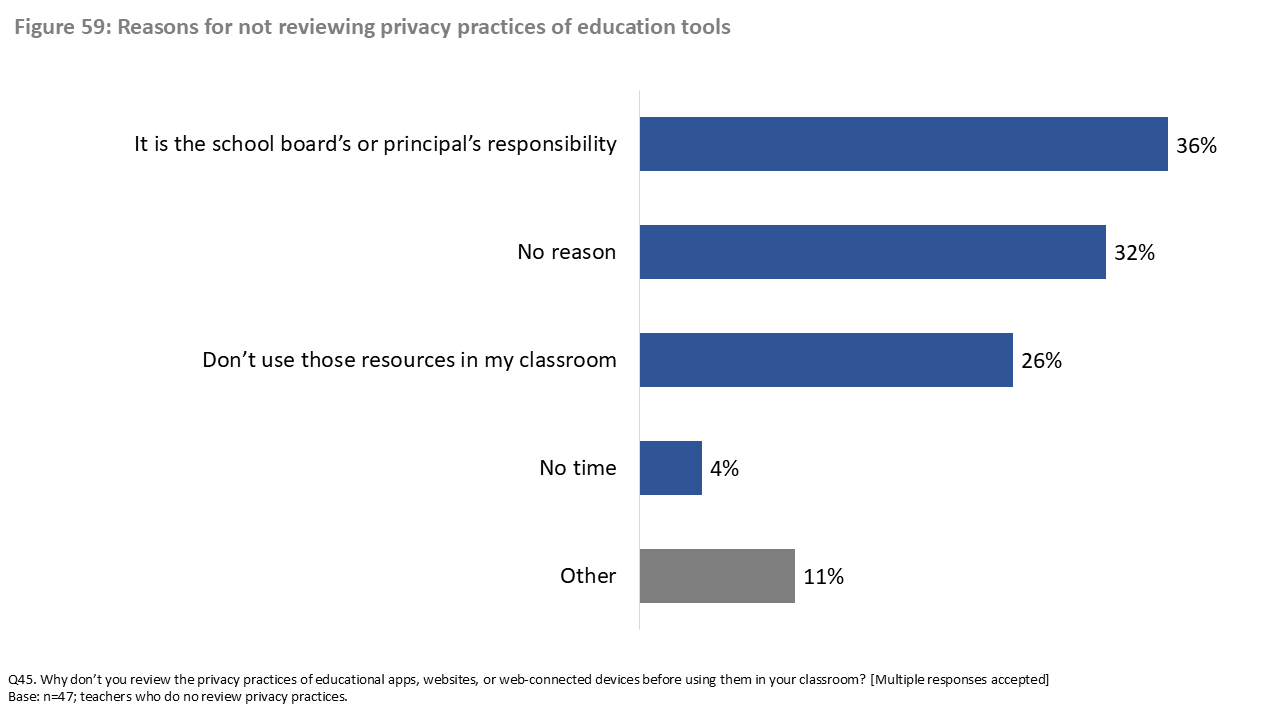
Text version of Figure 59
Figure 59: Reasons for not reviewing privacy practices of education tools
Q45. Why don’t you review the privacy practices of educational apps, websites, or web-connected devices before using them in your classroom? [Multiple responses accepted]
| Reasons | % of respondents |
|---|---|
| It is the school board’s or principal’s responsibility | 36% |
| No reason | 32% |
| Don’t use those resources in my classroom | 26% |
| No time | 4% |
| Other | 11% |
| Base: n=47; teachers who do no review privacy practices. | |
2.2.6 Awareness of federal institutions that help Canadians deal with privacy
Roughly three in 10 (28%) teachers surveyed are aware of federal institutions that help Canadians deal with privacy and the protection of personal information.

Text version of Figure 60
Figure 60: Awareness of federal privacy institutions
Q46. Are you aware of any federal institutions that help Canadians deal with privacy and the protection of personal information?
| Level of awareness | % of respondents |
|---|---|
| Aware | 28% |
| Not aware | 57% |
| Don’t Know | 16% |
| Base: n=109; teachers. | |
The vast majority of teachers have not used any of the OPC’s resources.
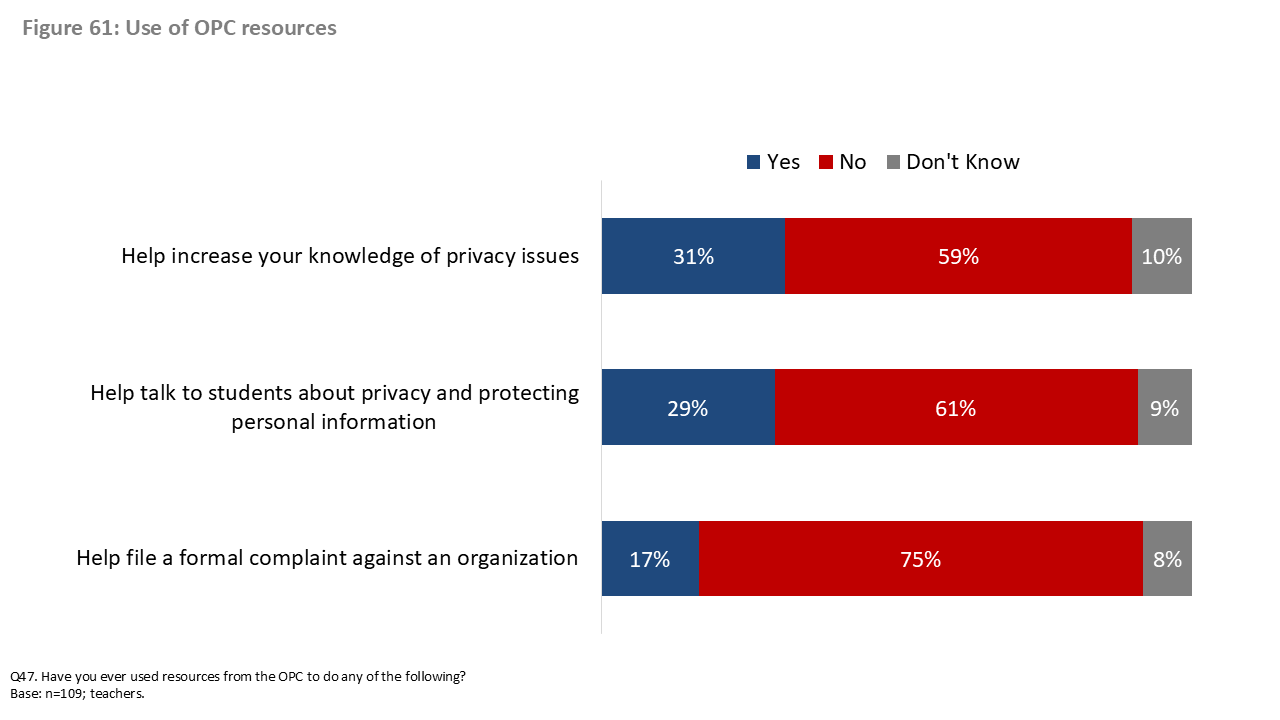
Text version of Figure 61
Figure 61: Use of OPC resources
Q47. Have you ever used resources from the OPC to do any of the following?
| Uses | Yes | No | Don’t Know |
|---|---|---|---|
| Help increase your knowledge of privacy issues | 31% | 59% | 10% |
| Help talk to students about privacy and protecting personal information | 29% | 61% | 9% |
| Help file a formal complaint against an organization | 17% | 75% | 8% |
| Base: n=109; teachers. | |||
2.2.7 Information Needs
Surveyed teachers pointed to a variety of resources that they would find helpful as teachers, as shown in Figure 62.
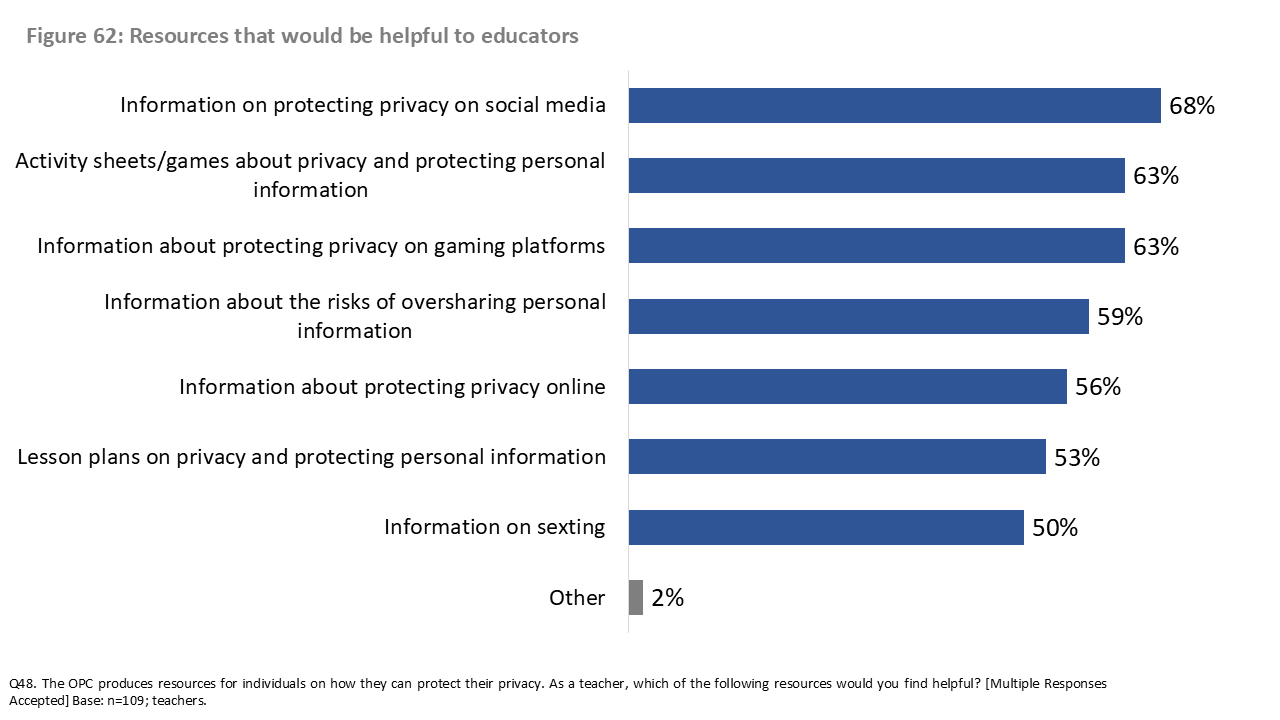
Text version of Figure 62
Figure 62: Resources that would be helpful to educators
Q48. The OPC produces resources for individuals on how they can protect their privacy. As a teacher, which of the following resources would you find helpful? [Multiple Responses Accepted]
| Resources | % of respondents |
|---|---|
| Information on protecting privacy on social media | 68% |
| Activity sheets/games about privacy and protecting personal information | 63% |
| Information about protecting privacy on gaming platforms | 63% |
| Information about the risks of oversharing personal information | 59% |
| Information about protecting privacy online | 56% |
| Lesson plans on privacy and protecting personal information | 53% |
| Information on sexting | 50% |
| Other | 2% |
| Base: n=109; teachers. | |
Teachers use a wide range of different sources for teaching materials, including online search tools (56%), their school board (50%), their professional organization or association (49%), and friends, colleagues or family members (47%). The complete list of sources can be found in Figure 63.
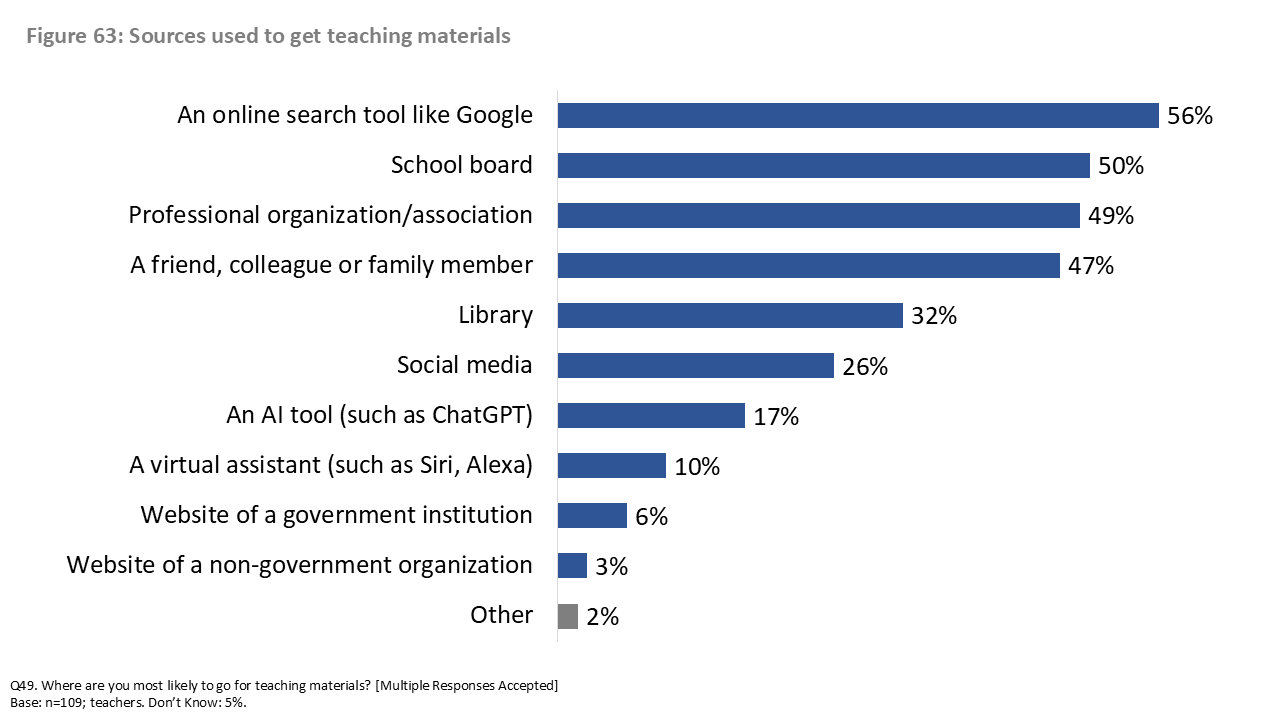
Text version of Figure 63
Figure 63: Sources used to get teaching materials
Q49. Where are you most likely to go for teaching materials? [Multiple Responses Accepted]
| Sources | % of respondents |
|---|---|
| An online search tool like Google | 56% |
| School board | 50% |
| Professional organization/association | 49% |
| A friend, colleague or family member | 47% |
| Library | 32% |
| Social media | 26% |
| An AI tool (such as ChatGPT) | 17% |
| A virtual assistant (such as Siri, Alexa) | 10% |
| Website of a government institution | 6% |
| Website of a non-government organization | 3% |
| Other | 2% |
| Base: n=109; teachers. Don’t Know: 5%. | |
Short 1-2-minute videos are the format preferred by the single greatest proportion of surveyed teachers—57%. Following this, 46% prefer classroom activities, 42% infographics and 41% fully crafted lesson plans. See Figure 64 for the full list of formats preferred for teaching resources.

Text version of Figure 64
Figure 64: Preferred format for teaching resources
Q50. What format do you prefer for your teaching resources for your students? [Multiple Responses Accepted]
| Formats | % of respondents |
|---|---|
| Short 1–2-minute videos | 57% |
| Classroom activities | 46% |
| Infographics | 42% |
| Fully crafted lesson plans | 41% |
| Instructional how-to guides | 32% |
| Emails or e-newsletters | 30% |
| Information pages, FAQs, online resource hubs | 29% |
| Social media posts, images, or stories | 26% |
| Podcasts or other audio content | 23% |
| Full reports available on websites | 21% |
| Other | 1% |
| Base: n=109; teachers. | |
Profile of Survey Respondents
The tables in this section present profiles of the research participants.
1.1 Telephone Survey
| Province/Territory | Weighted percentage of the survey sample |
|---|---|
| Atlantic Canada | 7% |
| Quebec | 23% |
| Ontario | 38% |
| Prairies | 17% |
| British Columbia | 14% |
| Territories | 1% |
| Gender | Weighted percentage of the survey sample |
|---|---|
| Men | 49% |
| Women | 50% |
| Another gender / non-binary | 1% |
| Age | Weighted percentage of the survey sample |
|---|---|
| 16 to 24 years old | 12% |
| 25 to 34 years old | 16% |
| 35 to 54 years old | 31% |
| 55 years old or older | 39% |
| Education | Weighted percentage of the survey sample |
|---|---|
| Less than a High School diploma or equivalent | 4% |
| High School diploma or equivalent | 20% |
| Registered Apprenticeship or other trades certificate or diploma | 5% |
| College, CEGEP or other non-university certificate or diploma | 22% |
| University certificate or diploma below bachelor’s level | 9% |
| Undergraduate university program | 21% |
| Post graduate degree above bachelor’s level | 16% |
| Prefer not to answer | 2% |
| Household income | Weighted percentage of the survey sample |
|---|---|
| Under $40,000 | 15% |
| $40,000 to just under $60,000 | 11% |
| $60,000 to just under $80,000 | 10% |
| $80,000 to just under $100,000 | 12% |
| $100,000 to just under $150,000 | 12% |
| $150,000 and above | 18% |
| Prefer not to answer | 23% |
| Disability | Weighted percentage of the survey sample |
|---|---|
| Person with disability | 11% |
| No disability | 88% |
| Prefer not to answer | 1% |
| Indigenous person | Weighted percentage of the survey sample |
|---|---|
| Indigenous | 6% |
| Non-Indigenous | 93% |
| Prefer not to answer | 2% |
| Racialized population | Weighted percentage of the survey sample |
|---|---|
| Member of a racialized community | 19% |
| Not a member of a racialized community | 79% |
| Prefer not to answer | 2% |
| Language spoken at home * Multiple responses accepted |
Weighted percentage of the survey sample |
|---|---|
| English | 72% |
| French | 24% |
| Other languages | 8% |
1.2 Online Survey – Parents
| Region of residence | Weighted percentage of the survey sample |
|---|---|
| Atlantic Canada | 7% |
| Quebec | 23% |
| Ontario | 39% |
| West | 32% |
| Gender | Weighted percentage of the survey sample |
|---|---|
| Men | 49% |
| Women | 51% |
| Another gender | <1% |
| Age of parent | Weighted percentage of the survey sample |
|---|---|
| Under 35 | 8% |
| 35 to 44 years | 53% |
| 45 to 54 years | 32% |
| 55 to 64 years | 7% |
| Language spoken at home * Multiple responses accepted |
Weighted percentage of the survey sample |
|---|---|
| English | 73% |
| French | 24% |
| Other languages | 7% |
| Indigenous parents | Weighted percentage of the survey sample |
|---|---|
| First Nations, Métis, Inuk | 4% |
| Non-Indigenous | 96% |
| Racialized parents | Weighted percentage of the survey sample |
|---|---|
| Member of a racialized community | 23% |
| Not a member of a racialized community | 76% |
| Education level of parent | Weighted percentage of the survey sample |
|---|---|
| Up to a high school diploma or equivalent | 13% |
| Registered Apprenticeship or other trades certificate or diploma | 6% |
| College, CEGEP or other non-university certificate or diploma | 30% |
| University certificate or diploma below bachelor’s level | 7% |
| Undergraduate university program | 27% |
| Post graduate degree above bachelor’s level | 17% |
| Household income | Weighted percentage of the survey sample |
|---|---|
| Under $40,000 | 10% |
| $40,000 to just under $60,000 | 8% |
| $60,000 to just under $80,000 | 18% |
| $80,000 to just under $100,000 | 16% |
| $100,000 to just under $150,000 | 24% |
| $150,000 and above | 17% |
| Prefer not to answer | 7% |
| Age of children | Weighted percentage of the survey sample |
|---|---|
| 6 years old | 16% |
| 7 years old | 10% |
| 8 years old | 16% |
| 9 years old | 16% |
| 10 years old | 16% |
| 11 years old | 15% |
| 12 years old | 15% |
| 13 years old | 16% |
| 14 years old | 17% |
| 15 years old | 17% |
| 16 years old | 11% |
| 17 years old | 10% |
| Child and Teen * Multiple responses accepted |
Weighted percentage of the survey sample |
|---|---|
| Children (ages 6 to 12) | 69% |
| Teens (ages 13 to 17) | 56% |
| Gender of Child and Teen * Multiple responses accepted |
Weighted percentage of the survey sample |
|---|---|
| Girl | 68% |
| Boy | 70% |
| Another gender | 1% |
1.3 Online Survey – Teachers
| Grade Taught | Unweighted percentage of the survey sample |
|---|---|
| Kindergarten | 13% |
| Grade 1 | 16% |
| Grade 2 | 15% |
| Grade 3 | 17% |
| Grade 4 | 19% |
| Grade 5 | 21% |
| Grade 6 | 23% |
| Grade 7/ Secondary 1 | 23% |
| Grade 8/ Secondary 2 | 20% |
| Grade 9/ Secondary 3 | 27% |
| Grade 10/ Secondary 4 | 32% |
| Grade 11/ Secondary 5 | 27% |
| Grade 12 | 23% |
| Region of employment | Unweighted percentage of the survey sample |
|---|---|
| Atlantic Canada | 6% |
| Quebec | 35% |
| Ontario | 38% |
| West | 21% |
| Gender | Unweighted percentage of the survey sample |
|---|---|
| Men | 47% |
| Women | 52% |
| Another gender | 1% |
| Age of teacher | Unweighted percentage of the survey sample |
|---|---|
| Under 35 years | 23% |
| 35 to 44 years | 41% |
| 45 to 54 years | 23% |
| 55 to 64 years | 12% |
| Language spoken at home * Multiple responses accepted |
Unweighted percentage of the survey sample |
|---|---|
| English | 66% |
| French | 38% |
| Other languages | 4% |
| Racialized teachers | Unweighted percentage of the survey sample |
|---|---|
| Member of a racialized community | 23% |
| Not a member of a racialized community | 76% |
| Education level of teacher | Unweighted percentage of the survey sample |
|---|---|
| Below a Bachelor’s degree | 14% |
| Bachelor’s degree | 52% |
| Post graduate degree above bachelor’s level | 33% |
| Household income | Unweighted percentage of the survey sample |
|---|---|
| Under $80,000 | 20% |
| $80,000 to just under $100,000 | 22% |
| $100,000 to just under $150,000 | 27% |
| $150,000 and above | 23% |
| Prefer not to answer | 8% |
Appendix
1. Technical Specifications
1.1 Telephone Survey
The following specifications applied to this survey:
- A 19-minute random digit dialling (RDD) telephone survey was administered to 1,500 Canadian residents, 16 years of age or older, between February 10 and March 3, 2025. Based on a sample of this size, the overall results can be considered accurate within ±2.5%, 19 times out of 20. The margin of error is greater for results pertaining to subgroups of the total sample.
- The questionnaire was pre-tested in advance of the fieldwork to ensure that it measured what it intended to measure and that respondents understood the questions. Following the pre-test, several changes were made to the questionnaire to reduce the average length of the interview. Changes included the removal of questions, the use of split samples, and minor wording revisions.
- An overlapping dual-frame (landline and cell phone) sample was used to minimize coverage error: 600 interviews were completed using the landline sample and 900 interviews were completed using the cell phone sample. The same random selection process was used for both the landline and cell phone sample, thereby ensuring the integrity of the probability sample.
- The sample frame was geographically disproportionate to improve the accuracy of regional results. The distribution of completed surveys is presented in the bullet below.
- A minimum of five call attempts were made before a record was retired or replaced. These call attempts varied by day of the week and time of day over a minimum seven-day period. No calling was conducted after 9 pm in each time zone, and no attempt was made to call back refusals.
- Interviews were conducted in the respondents’ official language of choice: 1,160 interviews were completed in English and 340 in French.
- The following table presents information about the final call dispositions for this survey and calculation of the response rate:
Final call dispositions for this survey and calculation of the response rate Total Landline Cell Total Numbers Attempted 115,310 22,110 93,200 Out-of-scope - Invalid 69,946 10,649 59,297 Unresolved (U) 27,562 6,023 21,539 No answer/Answering machine 27,562 6,023 21,539 In-scope - Non-responding (IS) 16,169 4,813 11,356 Language barrier 353 100 253 Incapable of completing (ill/deceased) 145 85 60 Callback (Respondent not available) 1,285 290 995 Refusal 13,816 4,201 9,615 Termination 570 137 433 In-scope - Responding units (R) 1,633 625 1,008 Completed Interview 1,500 600 900 Not Qualified – Employment exclusions 21 0 21 Not Qualified – Age 50 7 43 Quota Filled 62 18 44 - The overall response rate was 4% (5% for the landline sample and 3% for the cell phone sample). The response rate formula is calculated as follows: [R=R/(U+IS+R)]. This means that the response rate is calculated as the number of responding units [R] divided by the number of unresolved [U] numbers plus in-scope [IS] non-responding households and individuals plus responding units [R].
- The survey data have been weighted by region, age, and gender using population figures from Statistics Canada’s 2021 census data. The weights correct for the disproportionate regional sampling. Any respondents who refused to provide their age were given a neutral weight so as not to skew the weighting proportions. The table below shows the unweighted and weighted proportions for the variables used to create the weights:
Base Unweighted
n=1,500Weighted
n=1,500Region Atlantic Canada 200 104 Quebec 350 340 Ontario 400 576 Prairies * 350 267 British Columbia ** 200 212 Age 16 to 24 80 185 25 to 34 142 236 35 to 54 377 461 55 or older 866 582 Refused 35 35 Gender Woman 730 754 Man 760 736 Another gender/non-binary 10 10 * Includes Nunavut and the Northwest Territories. ** Includes the Yukon Territory. - A non-response analysis was conducted to assess the potential for non-response bias. Survey non-response can bias results when there are systematic differences between survey respondents and non-respondents. The survey sample (the unweighted percentages in the tables above) very closely mirrors the distribution of the population by gender and region (the weighted percentages in the tables above). Differences are evident for age, however, which is often the case for surveys of the general public—specifically, the survey underrepresented 16- to 34-year-olds. This was corrected by weighting.
1.2 Online Survey
The following specifications applied to this survey:
- An online survey was administered to 411 online panellists who met the eligibility requirements.
- The survey sample was drawn from the Leger Opinion panel (LEO). Surveys that use samples drawn from online panels cannot be described as statistically projectable to the target population.
- Panellists were invited to participate in the survey through an email invitation which contained a password-protected URL to access the survey.
- All survey respondents were informed that their participation was voluntary, and that information collected was protected under the authority of privacy legislation.
- Sponsorship of the study was revealed (i.e., the Government of Canada).
- Panellists were rewarded for taking part in the survey per the panel’s incentive program, which is structured to reflect the length of survey and the nature of the sample.
- The survey averaged eight minutes to complete, and the fieldwork was conducted February 25 to 28, 2025.
- The survey questionnaire was programmed using computer-assisted web interviewing (CAWI) technology. The programming was tested for skip logic by the initial programmer, as well as by a second senior programmer.
- Following survey best practices, the questionnaire was pre-tested in advance of the fieldwork. No issues were identified during the pre-test.
- The parents survey data were weighted by region and gender to reflect the population, using 2021 Census data. The teachers survey data were not weighted.
- The participation rate was 11%, calculated using the formula outlined in the Standards for the Conduct of Government of Canada Public Opinion Research (Online Surveys).
Participation Rate = R/(U+IS+R) Sample Total Sample Used 5,142 Unresolved (U) 2 Undeliverable email invitations 2 In-scope non-responding units (IS) 4,579 Respondent break-off 57 Did not complete / accept the invitation to participate 4,522 Responding units (R) 561 Completed survey 411 Disqualified 60 Over quota 33 Participation Rate = R/(U+IS+R) 11%
2. Survey Questionnaire – Telephone
Introduction
Hello / Bonjour (pause), the Government of Canada is conducting a research survey on issues of interest to Canadians. Would you prefer that I continue in English or French? Préférez-vous continuer en français ou en anglais?
My name is [Interviewer’s name]. I’m calling on behalf of Phoenix SPI, a public opinion research company. The survey takes approximately 15 minutes. Should you have any questions about the survey, I can give you a contact person within the Government of Canada.* Your participation is voluntary and confidential. Your answers will remain anonymous, and the information you provide will be administered according to the requirements of Canada’s privacy laws. May I continue?
*[IF NEEDED, PLEASE PROVIDE THE FOLLOWING: communications@priv.gc.ca or OPC Information Centre 1-800-282-1376.]
[LANDLINE SAMPLE]
A. We choose telephone numbers at random and then select one person from each household to be interviewed. To do this, we would like to speak to the person in your household, 16 years of age or older, who has had the most recent birthday. Would that be you?
02. No - ASK TO SPEAK TO ELIGIBLE PERSON; REPEAT INTRO
[CELL SAMPLE]
B. Are you 16 years of age or older?
02. No - THANK/DISCONTINUE
C. Are you in a place where you can talk safely on the phone and answer my questions?
02. No - ASK D
D. We would like to conduct this interview with you when it is safe and convenient to do. When would it be more convenient for me to call back?
SCHEDULE CALL-BACK IF POSSIBLE (TIME/DAY):
[EVERYONE]
E. Do you work in any of the following areas? [READ LIST]
02. The media (i.e. TV, radio, newspapers)
THANK/DISCONTINUE IF ANY OF THE ABOVE
THANK/DISCONTINUE MESSAGE: “Thank you for your willingness to take part in this survey, but you do not meet the eligibility requirements of this study.”
F. In which province or territory do you live?
02. Prince Edward Island
03. Nova Scotia
04. New Brunswick
05. Quebec
06. Ontario
07. Manitoba
08. Saskatchewan
09. Alberta
10. British Columbia
11. Yukon
12. Northwest Territories
13. Nunavut
G. Do you identify as a person with a disability?
02. No
03. [DO NOT READ] Prefer not to answer
PROGRAMMING NOTES:
- Accept Don’t know and Refused for all questions if volunteered by a respondent.
- Record Don’t know and Refused separately for all questions.
- For questions about the legitimacy of the survey, invite the respondents to use the Canadian Research Insights Council’s Research Verification Service. PROJECT NUMBER: 20250114-PH449.
Knowledge and Trust
Many of the questions in this survey are about privacy and the protection of personal information. Personal information can include things like your name, income, and email address, as well as information like your purchasing habits, and online activities.
1. In general, are you concerned about the protection of your privacy? Please use a scale of 1 to 7, where ‘1’ means not concerned at all, and ‘7’ means extremely concerned. [Yearly TRACKING-MODIFIED in 2020]
2. Using a scale of 1 to 7, where ‘1’ means very poor and ‘7’ means very good, how would you rate your knowledge of the following… [DRR TRACKING]
[READ/ROTATE]
b. How to protect your privacy? [MODIFIED IN 2024/25]
c. Existing privacy laws in Canada? [NEW]
3. Please tell me how much you agree or disagree with the following statements. To do so, use another 7-point scale, this time where ‘1’ means you strongly disagree and ‘7’ means you strongly agree. [DRR TRACKING]
[READ/ROTATE]
b. [SPLIT SAMPLE: 50%] I feel that the Government of Canada in general respects my privacy rights.
c. I feel confident that I know how new technologies might affect my personal privacy. [MODIFIED IN 2024/25]
d. I don’t know what to do if I think that my personal information is part of a privacy breach. [NEW]
4. How much trust do you have in the following organizations to protect the personal information you share with them? Do you have a great deal of trust, a fair amount of trust, not much trust, or no trust at all in… [READ/ROTATE ITEMS]? [YEARLY TRACKING]
b. Telecommunications and internet service providers [MODIFIED IN 2022/23]
c. Retailers
d. Social media companies [MODIFIED IN 2024/25]
e. “Big tech” INTERVIEWER: IF ASKED WHAT IS MEANT BY “BIG TECH” SAY: This refers to companies like Microsoft, Amazon, Apple and Alphabet, Google’s parent company. [MODIFIED IN 2024/25]
f. Law enforcement agencies like police and border officers
Privacy Concerns
These next questions deal with issues related to online privacy and privacy on mobile devices.
[IF RESPONDENTS VOLUNTEER THAT THEY DO NOT USE THE INTERNET OR HAVE A MOBILE DEVICE, RECORD THIS AND THEN SKIP TO Q7]
5. Are you concerned about your privacy with respect to the following… [READ ITEM]. Please use a scale from 1 to 7, where ‘1’ means not concerned at all, and ‘7’ means extremely concerned.: [ROTATE ITEMS; ACCEPT DOES NOT APPLY IF VOLUNTEERED
b. Using social media
c. Your smartphone
d. Using other internet-connect devices, like those related to smart homes and smart cars
e. Using artificial intelligence (AI) tools
f. Providing personal information or biometrics to confirm your identity
6. [INTERNET USERS] Thinking about the personal information available about you online, and in smart devices, please tell me whether you’re concerned about each of the following happening. REPEAT SCALE IF NEEDED. How about…
[READ/ROTATE]
b. Your personal information being used to make decisions about you, such as for a job, an insurance claim, a loan, or health coverage. [MODIFIED IN 2024/25]
c. Your personal information being used to attempt to steal your identity. [MODIFIED IN 2024/25]
d. Your personal information being sold or shared with other companies or organizations. [NEW]
e. Your personal information being used to train AI systems. [NEW]
Privacy experiences and actions to protect privacy
7. The following questions focus on actions you may have taken when it comes to your personal information. Have you:… ? [ROTATE ITEMS; RECORD YES/NO; ACCEPT DOES NOT APPLY IF VOLUNTEERED.] [DRR TRACKING]
b. [INTERNET USERS] Adjusted privacy settings for other online or mobile app accounts such as those related to gaming, fitness, or shopping?
c. [INTERNET USERS] Deleted or stopped using an account because of privacy concerns?
d. [ALL] Refused to provide an organization or business with your personal information because of privacy concerns?
e. [ALL] Stopped doing business with a company that experienced a privacy breach?
8. [INTERNET USERS] Would you say it is very easy, somewhat easy, somewhat difficult or very difficult to [READ ITEM]? [ROTATE ITEMS; ACCEPT DOES NOT APPLY IF VOLUNTEERED] [NEW]
b. Change privacy settings on social media, mobile apps, or other types of online accounts
9. [ALL] Have you been impacted by a privacy breach? [MODIFIED; 2024/25]
02. No
03. I don’t know
10. [ALL] Compared to five years ago, how willing are you to share your personal information with organizations? Are you [READ]… [NEW]
02. Somewhat more willing
03. About the same
04. Somewhat less willing
05. Much less willing
06. [DO NOT READ] I don’t know
11. Please tell me how much you agree or disagree with the following statements. To do so, use a 7-point scale, where ‘1’ means you strongly disagree and ‘7’ means you strongly agree. [ROTATE ITEMS] [NEW]
b) [INTERNET USERS] When I share my personal information online, I often don’t know where it goes or how it’s used.
c) [INTERNET USERS] I generally find it is easy to delete an online account.
d) [ALL] I’m more likely to give extra personal information when I will get a deal or save money in return.
e) [INTERNET USERS] I’m more likely to give my personal information when a website or app keeps sending pop-ups asking me to do something.
Awareness of OPC and how its resources might be made more useful for Canadians
12. Are you aware of any federal institutions that help Canadians deal with concerns relating to the protection of personal information?
02. Yes
13. Have you ever heard of the Privacy Commissioner of Canada? [NEW]
02. No
The Office of the Privacy Commissioner of Canada, or the OPC, enforces Canada’s federal privacy laws in both the private and public sectors.
14. Have you ever obtained resources, guidance or other information about privacy from the OPC? [NEW]
02. No
03. I don’t know
15. Have you ever made a privacy complaint about a business or government institution? [NEW]
02. No
03. I don’t know
16. [IF Q15=01] Was this a formal complaint filed with a: [ROTATE ITEMS; RECORD YES/NO] [NEW]
02. Business
03. Government institution
04. [DO NOT ROTATE] Some other organization (please specify)
05. [VOLUNTEERED] I don’t know
17. The OPC produces resources for Canadians on how they can protect their privacy. What privacy topics would you like to have more information on? [DO NOT READ; ACCEPT MULTIPLE RESPONSES]. [NEW]
02. Protecting yourself against identity theft and fraud
03. Protecting the privacy of children and teens
04. Protecting your privacy online
05. What to do if you think a business or federal government institution has violated your privacy
06. AI and your privacy
07. Biometrics like facial recognition technology and your privacy
08. Privacy risks and protecting your personal information
09. I don’t know
10. Other (please specify)
18. When you need information on a specific topic, what do you typically do to find it? INTERVIEWER: IF PROMPTING IS NEEDED, SAY: Where or how would you look for this information? [DO NOT READ; ACCEPT MULTIPLE RESPONSES]. [NEW]
02. Ask an AI tool, such as ChatGPT
03. Ask a virtual assistant, such as Siri or Alexa
04. Go directly to a website I think will have the information
05. Use social media
06. Consult news reports or media sources
07. Ask a friend, colleague, or family member
08. Consult an expert or organization
09. I don’t know
10. Other (please specify)
19. [IF SCREENING QG=01] The Office of the Privacy Commissioner of Canada, or the OPC, wants to improve the accessibility of its online resources and services. Do you have any advice or suggestions to share with the OPC to make resources and services more accessible? [NEW]
02. No suggestions
Demographics
The last few questions are for classification purposes only. Your answers will remain anonymous and confidential.
20. In what year were you born?
02. [DO NOT READ] Prefer not to answer
21. [ASK IF Q21=02] Would you be willing to tell me in which of the following age categories you belong? Please stop me at the category that best describes you… [READ]
02. 18 to 24
03. 25 to 34
04. 35 to 44
05. 45 to 54
06. 55 to 64
07. 65 or older
08. [DO NOT READ] Prefer not to answer
22. How do you identify your gender? [READ; STOP WHEN A SELECTION IS MADE]
02. Man
03. Non-binary
04. Another gender
05. [DO NOT READ] Prefer not to answer
23. What language do you speak most often at home? [READ; ACCEPT MULTIPLE RESPONSES]
02. French
03. Other: (please specify) [NEW]
04. [DO NOT READ] Prefer not to answer
24. Are you First Nations, Métis or Inuk (Inuit)?
02. No
03. [DO NOT READ] Prefer not to answer
25. [SKIP IF Q24=01] Do you identify with a racialized population group? Racialized groups include, among others, South Asian, Chinese, Black, Filipino, Arab, Latin American, Southeast Asian, West Asian, Korean and Japanese. [NEW]
02. No
03. [DO NOT READ] Prefer not to answer
26. What is the highest level of formal education that you have completed? Please stop me at the category that best describes you… [READ LIST]
02. High School diploma or equivalent
03. Registered Apprenticeship or other trades certificate or diploma
04. College, CEGEP or other non-university certificate or diploma
05. University certificate or diploma below bachelor’s level
06. Bachelor’s degree
07. Postgraduate degree above bachelor’s level
08. [DO NOT READ] Prefer not to answer
27. Which of the following best describes your total household income last year, before taxes, from all sources for all household members? [READ LIST] [NEW]
02. $20,000 to just under $40,000
03. $40,000 to just under $60,000
04. $60,000 to just under $80,000
05. $80,000 to just under $100,000
06. $100,000 to just under $150,000
07. $150,000 and above
08. [DO NOT READ] Prefer not to answer
That concludes the survey. Thank you very much for your thoughtful feedback. It is much appreciated. This survey was conducted on behalf of the Privacy Commissioner of Canada.
3. Survey Questionnaire – Online
Thank you for agreeing to take part in this short survey being conducted by Phoenix Strategic Perspectives (Phoenix SPI) on behalf of the Government of Canada. Si vous préférez répondre au sondage en français, veuillez cliquer sur « Français » dans le coin supérieur droit.
This survey is designed to collect information on issues of importance to Canadians. It should take no more than 7 minutes to complete, is voluntary, and your responses will be kept completely confidential. The information provided will be administered according to the requirements of the Privacy Act. Your responses will not be used to identify you, and none of your opinions will be attributed to you personally in any way. To view Phoenix SPI’s privacy policy, click <here>.
This survey is registered with the Canadian Research Insights Council’s Research Verification Service. The project verification code is 20250114-PH449. Click <here> to verify the legitimacy of this survey.
Screener
1. Are you…
02. A teacher at a primary or secondary school in Canada [TEACHER]
03. None of the above [TERMINATE]
04. Prefer not to answer [TERMINATE]
2. Which of the following age groups do you fall into?
02. 18-24
03. 25-34
04. 35-44
05. 45-54
06. 55-64
07. 65-74 [TERMINATE]
08. 75 or older [TERMINATE]
09. Prefer not to answer [TERMINATE]
3. PARENTS: Where are you located? / TEACHERS: In which province or territory do you teach?
02. British Columbia
03. Manitoba
04. New Brunswick
05. Newfoundland and Labrador
06. Northwest Territories
07. Nova Scotia
08. Nunavut
09. Ontario
10. Prince Edward Island
11. Quebec
12. Saskatchewan
13. Yukon
14. Prefer not to answer [TERMINATE]
4. For the purposes of this survey, will you please provide your gender?
02. Man
03. Another gender
04. Prefer not to answer
5. [PARENT] How many children between the ages of 6 and 17 live at home with you, whether full- or part-time?
02. None [TERMINATE]
6. For each child between the ages of 6 and 17, please indicate their age and gender:
PROGRAMMING NOTE: The number of rows provided will match the number of children identified in Q5.
| Children | Age | Gender |
|---|---|---|
| Child 1: | ||
| Child 2: | ||
| Child 3: |
7. [TEACHER] Which of the following applies to you?
[ALLOW MULTIPLE RESPONSES]
02. I teach full or part-time at a secondary school (Grade 9 to 12)
03. None of the above [TERMINATE]
Questions for Parents
PROGRAMMING NOTE: If a respondent has a “child” and a “teen”, randomly assign them to one cohort: Child (6 to 12 years of age) or Teen (13-17 years of age).
Throughout this survey, “child” will be used to refer to children between ages of 6 and 12 and “teens” will refer to children 13 to 17 years of age.
8. Thinking about your child’s (children’s) / teen’s (teens’) online activities, are you concerned about the following:
[ROTATE]
b) The amount of personal information your child (children) / teen(s) are sharing about themselves online, including on social media.
c) Your child (children) / teen(s) using websites and mobile apps meant for adults.
d) Potential risks to your child (children) / teen(s) from the use or misuse of their personal information, such as online harms, manipulation, and safety risks.
[RESPONSE OPTIONS]
02. Slightly concerned
03. Moderately concerned
04. Very concerned
05. Extremely concerned
06. I don’t know
07. This doesn’t apply to my child (children)/teen(s)
9. How aware do you think your child (children) / teen(s) is of the potential risks of sharing their personal information? For example, sharing it online, with mobile apps, on social media, on gaming platforms or with businesses.
02. Slightly aware
03. Moderately aware
04. Very aware
05. Extremely aware
06. I don’t know
10. Who should be most responsible for protecting the privacy of children and teenagers? Please rank the options from most to least responsible.
[ROTATE]
02. Companies (for ex. social media, gaming platforms, online retailers)
03. Governments
04. Children and teenagers
05. Educators
06. Other (please specify) [ANCHOR]
07. None of the above [ANCHOR]
08. I don’t know [ANCHOR]
11. How responsible do you feel as a parent for guiding your child (children) / teen(s) in making safe online decisions and protecting their privacy?
02. Slightly responsible
03. Moderately responsible
04. Very responsible
05. Extremely responsible
06. I don’t know
12. Should parents be involved in their child(dren’s) / teen(s’) online activities, such as setting up an email, social media or other online account?
02. No
03. It depends
04. I don’t know
13. [IF Q12=03] You said it depends when asked if you should be involved before your child (children) / teen(s) opens an online account. What does it depend on?
02. I don’t know
14. Have you ever discussed the protection of personal information with your child (children) / teen (s)?
02. No [SKIP TO Q18]
03. I don’t know [SKIP TO Q18]
15. [ASK IF Q14=01] How capable did you feel discussing the protection of personal information with your child (children) / teen (s)?
02. Slightly capable
03. Moderately capable
04. Very capable
05. Extremely capable
06. I don’t know
16. [ASK IF Q14=01] How often do you discuss privacy and the protection of personal information with your child (children) / teen (s)?
02. At least once a month
03. 2 or 3 times a year
04. Once a year or less
17. [ASK IF Q14=01] Which of the following topics have you discussed with your child (children) / teen (s)?
Select all that apply
[ROTATE]
02. Oversharing information online
03. Privacy on gaming websites
04. Setting passwords and usernames
05. Online scams
06. Adjusting privacy settings
07. Privacy and mobile devices like smartphones and tablets
08. Privacy and downloading apps
09. Tagging other people in photos and videos
10. Using a webcam
11. Privacy policies
12. Online shopping
13. Deepfakes
14. Cyberbullying/online impersonation/snooping
15. Sexting (sharing intimate images/conversations)
16. When to seek out an adult for help
17. Other (please specify) [ANCHOR]
18. [ASK IF Q14=02 or 03] How capable would you feel discussing the protection of their personal information online with them?
02. Slightly capable
03. Moderately capable
04. Very capable
05. Extremely capable
06. I don’t know
19. How much trust do you have in companies to protect the personal information of young people?
02. Not much trust
03. A fair amount of trust
04. A great deal of trust
05. I don’t know
20. How often do you consider the privacy practices of the following services before allowing your child (children) / teen (teens) to use them?
[ROTATE]
b. Mobile apps
c. Gaming platforms
d. Educational platforms *
e. Smart devices, like phones and watches
* PROVIDE DEFINITION OF EDUCATIONAL PLATFORMS FOR RESPONDENTS TO ACCESS IF THEY WANT/NEED IT: This refers to online learning environments, such as Google Classroom, Kahoot!, Seesaw, or D2L Brightspace.
[RESPONSE OPTIONS]
02. Sometimes
03. Never
04. I don’t know
21. Do you apply parental controls where available, for instance on mobile devices, websites, mobile apps, streaming services, etc.?
02. Sometimes
03. Never
04. I don’t know
22. [IF Q21=03] Why do you never apply parental controls?
Select all that apply
[ROTATE]
02. I didn’t know about parental controls
03. I don’t like parental controls
04. I don’t have time to figure out how to use parental controls
05. Some other reason: [ANCHOR]
06. I don’t know
23. Do you know of any programs or resources that teach kids or teens about data privacy and safe online practices?
02. No
03. I don’t know
24. [ASK IF Q23=01] Please name the programs or resources you know about that teach kids or teens about data privacy and safe online practices:
02. I can’t recall
25. Are you aware of any federal institutions that help Canadians deal with privacy and the protection of personal information?
02. No
03. I don’t know
26. [ASK IF Q25=01] Which federal institutions are you aware of that help Canadians deal with the privacy and protection of personal information?
02. I can’t recall
27. Have you ever heard of the Privacy Commissioner of Canada?
02. No
The Office of the Privacy Commissioner of Canada, or the OPC, enforces Canada’s federal privacy laws in both the private and public sectors.
28. Have you ever used resources from the OPC to do any of the following?
[ROTATE]
b. help file a formal complaint against an organization
c. help talk to your child (children) or teen(s) about privacy and protecting their personal information?
[RESPONSE OPTIONS]
02. No
03. I don’t know
29. The OPC produces resources for individuals on how they can protect their privacy. As a parent, which of the following resource topics would you find helpful?
Select all that apply
[ROTATE]
02. Talking to your child/teen about the risks of oversharing personal information online
03. What to do if your child/teen’s information is exposed in a cyberattack or data breach
04. Setting house rules for safe internet, gaming or social media use
05. Protecting yourself against identity theft and fraud
06. Protect your child/teen’s privacy online
07. Sexting
08. Other (please specify) [ANCHOR]
09. None of these [ANCHOR]
10. I don’t know [ANCHOR]
30. When you are trying to find information on a parenting topic, which of the following do you typically do?
Select all that apply
[ROTATE]
02. Ask an AI tool, such as ChatGPT
03. Ask a virtual assistant, such as Siri or Alexa
04. Go directly to a website I think will have the information
05. Use social media
06. Ask a friend or family member
07. Other (please specify) [ANCHOR]
08. None of these [ANCHOR]
09. I don’t know [ANCHOR]
[PARENTS GO TO DEMOGRAPHICS]
Questions for Teachers
Throughout this survey, “child” will be used to refer to children between the ages of 6 and 12 and “teens” will refer to children 13 to 17 years of age.
31. What grades do you teach?
Select all that apply
| [OPTIONS IF Q3 ≠ 11] | [OPTIONS IF Q3 = 11] |
|---|---|
|
|
32. Thinking about the typical students you work with, are you concerned about the following:
[ROTATE ITEMS]
b) How much personal information students are sharing themselves online, including on social media.
c) Students using websites and mobile apps meant for adults.
d) Potential risks to students that may result from the use or misuse of their personal information, including online harms, manipulation, and safety risks.
[RESPONSE OPTIONS]
02. Slightly concerned
03. Moderately concerned
04. Very concerned
05. Extremely concerned
06. I don’t know
33. Do you think your students understand the potential long-term consequences of posting material online?
02. No
03. I don’t know
34. How capable do you think your students are at protecting their privacy online?
02. Slightly capable
03. Moderately capable
04. Very capable
05. Extremely capable
06. I don’t know
35. Who is most responsible for protecting the privacy of children and teenagers? Please rank the options from most to least responsible.
[ROTATE]
02. Companies (for ex. social media, gaming platforms, online retailers)
03. Governments
04. Children and teenagers themselves
05. Educators
06. Other (please specify) [ANCHOR]
07. None of the above [ANCHOR]
08. I don’t know [ANCHOR]
36. Have you ever discussed privacy and the protection of personal information with your students?
02. No [SKIP TO Q40]
03. I don’t know [SKIP TO Q40]
37. [ASK IF Q36=01] How capable did you feel discussing the privacy and protection of personal information with your students?
02. Slightly capable
03. Moderately capable
04. Very capable
06. I don’t know
38. [ASK IF Q36=01] How do you discuss matters related to privacy and the protection of personal information with your students?
Select all that apply
[ROTATE]
02. As part of discussions when it makes sense
03. I invite experts into the classroom to help teach this material
04. I use teaching materials on the subject
05. Other (please specify) [ANCHOR]
39. [ASK IF Q36=01] Which of the following topics have been addressed in your classroom?
Select all that apply
[ROTATE]
02. Sexting (sharing intimate images/conversations)
03. Oversharing information online
04. Privacy on gaming websites
05. Setting passwords and usernames
06. Adjusting privacy settings
07. Privacy policies
08. When to seek out an adult for help
09. Online shopping
10. Cyberbullying/online impersonation/snooping
11. Privacy and mobile devices like smartphones and tablets
12. Privacy and downloading apps
13. Tagging other people in photos and videos
14. Using a webcam
15. Online scams
16. Other (please specify) [ANCHOR]
40. [ASK IF Q36=02 or 03] How capable would you feel discussing the privacy and protection of personal information with your students?
02. Slightly capable
03. Moderately capable
04. Very capable
05. Extremely capable
06. I don’t know
41. [ASK IF Q36=02 or 03] Why haven’t you discussed privacy and the protection of personal information with your students?
Select all that apply
[ROTATE]
02. It hasn’t come up
03. I didn’t think it was important
04. I do not feel comfortable/knowledgeable enough to discuss this
05. I do not have sufficient teaching resources on this subject
06. Other (please specify) [ANCHOR]
07. I don’t know [ANCHOR]
42. Do you know any programs or resources that teach children or teens about privacy and safe online practices?
02. No
03. I don’t know
43. [ASK IF Q42=01] Please name the programs or resources you know about that teach children or teens about safe data privacy practices:
02. No suggestions
44. Do you review the privacy practices of educational apps, websites, or web-connected devices before using them in your classroom?
02. No
45. [IF Q44=02] Why don’t you review the privacy practices of educational apps, websites, or web-connected devices before using them in your classroom?
02. It is the school board or principal’s responsibility
03. I don’t use those resources in my classroom
04. Other (please specify) [ANCHOR]
46. Are you aware of any federal institutions that help Canadians deal with privacy and the protection of personal information?
02. No
03. I don’t know
The Office of the Privacy Commissioner of Canada, or the OPC, enforces Canada’s privacy laws in both the private and public sectors.
47. Have you ever used resources from the OPC to do any of the following:
[ROTATE]
b. help file a formal complaint against an organization
c. help talk to your students about privacy and protecting their personal information
[RESPONSE OPTIONS]
02. No
03. I don’t know
48. The OPC produces resources for individuals on how they can protect their privacy. As a teacher, which of the following resources would you find helpful?
Select all that apply
[ROTATE]
02. Activity sheets/games about privacy and the protection of personal information
03. Information about the risks of oversharing personal information
04. Information on sexting
05. Information about protecting privacy online
06. Information about protecting privacy on gaming platforms
07. Information on protecting privacy on social media
08. Other (please specify) [ANCHOR]
49. Where are you most likely to go for teaching materials?
Select all that apply
[ROTATE]
02. An AI tool (such as ChatGPT)
03. A virtual assistant (such as Siri, Alexa)
04. Directly to the website of a relevant government institution – please specify:
05. Directly to the website of a relevant non-government organization – please specify:
06. Social media
07. A friend, colleague or family member
08. School board
09. Professional organization/association
10. Library
11. Other (please specify) [ANCHOR]
12. I don’t know [ANCHOR]
50. What format do you prefer for your teaching resources for your students?
Select all that apply
[ROTATE]
02. Short 1–2-minute videos on websites or social media
03. Social media posts, images, or stories
04. Infographics shared on websites, social media or via email
05. Podcasts or other audio content
06. Emails or e-newsletters
07. Full reports available on websites
08. Instructional how-to guides
09. Fully crafted lesson plans
10. Classroom activities created by a government, non-profit organization or business
11. Other (please specify) [ANCHOR]
Demographics
[ALL RESPONDENTS]
These last few questions are for background purposes. All responses will remain confidential.
51. What language do you speak most often at home?
Select all that apply
02. French
03. Other (please specify)
04. Prefer not to answer
52. Are you First Nations, Métis or Inuk (Inuit)?
02. No
03. Prefer not to answer
53. [SKIP IF Q52=01] Do you identify with a racialized population group? Racialized groups include, among others, South Asian, Chinese, Black, Filipino, Arab, Latin American, Southeast Asian, West Asian, Korean and Japanese.
02. No
03. Prefer not to answer
54. What is the highest level of formal education that you have completed?
02. High School diploma or equivalent
03. Registered Apprenticeship or other trades certificate or diploma
04. College, CEGEP or other non-university certificate or diploma
05. University certificate or diploma below bachelor’s level
06. Bachelor’s degree
07. Post graduate degree above bachelor’s level
08. Prefer not to answer
55. Which of the following best describes your total household income last year, before taxes, from all sources for all household members?
02. $20,000 to just under $40,000
03. $40,000 to just under $60,000
04. $60,000 to just under $80,000
05. $80,000 to just under $100,000
06. $100,000 to just under $150,000
07. $150,000 and above
08. Prefer not to answer
This completes the survey. On behalf of the Privacy Commissioner of Canada, we thank you for taking the time to share your feedback.
- Date modified:

